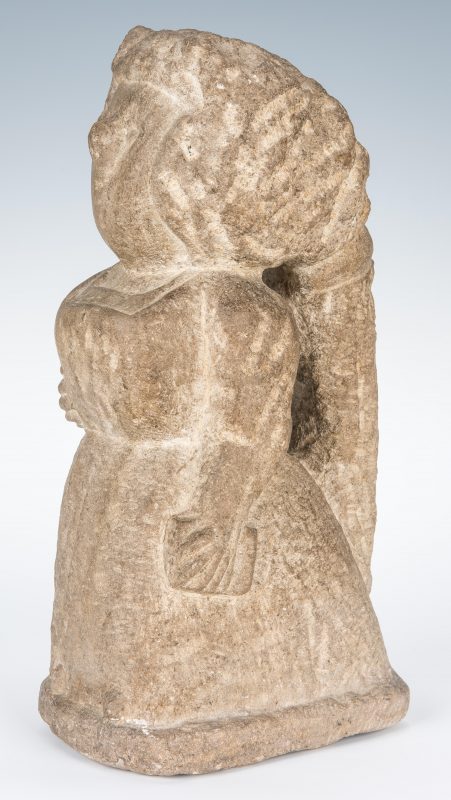 |
|
William Edmondson (American/Tennessee, 1874-1951), “Miss Amy” (This sculpture is the companion sculpture to the Edmondson sold in our January 26, 2019 auction, Lot #110, “Miss Lucy”). Carved limestone sculpture depicting a standing woman wearing a scoop neck dress, with elaborate hair and holding a book. 14 1/2″ H x 4 3/4″ W x 7 3/8″ D. Circa 1930/1935. Exhibited, “Will Edmondson’s Mirkels,” the Tennessee Fine Arts Center at Cheekwood (April 12 through May 21, 1964), and listed as #5 in the catalog, published by Louise Dahl-Wolfe. Additionally exhibited “The Art of William Edmondson,” the Tennessee Fine Arts Center at Cheekwood traveling exhibit (January 28 – April 23, 2000), and listed in the exhibition catalog “The Art of William Edmondson” on page 136, figure #23. Provenance: The estate of Janet Marsh Pruitt (Mrs. Earl Pruitt) of Pennsylvania, formerly of Nashville, Tennessee. By descent from her parents, Ross and Anna Marsh. |
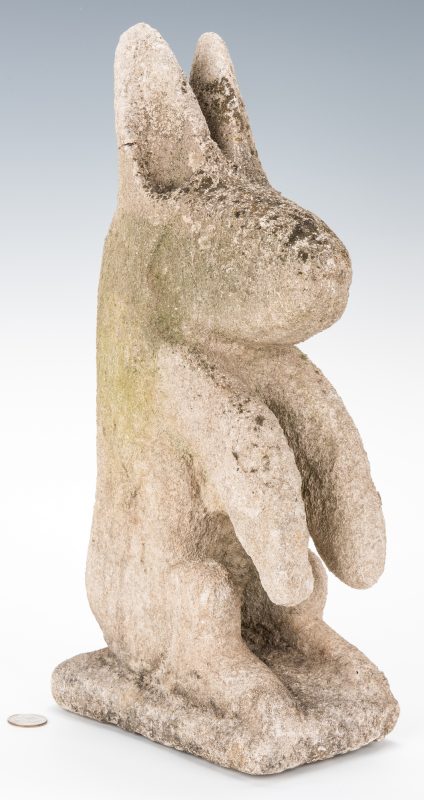 |
|
William Edmondson (American/Tennessee, 1874-1951) carved limestone sculpture of a rabbit with raised paws, sitting on its hind legs, atop a rectangular integral base. 16 5/8″ x 5″W x 7 1/2″ D. Rabbits were popular subject matter for Edmondson. A very similar rabbit is visible in the background of a photograph of Edmondson’s yard taken in 1941 by photographer Edward Weston (ref. Edmund L. Fuller, “Visions In Stone: the Sculpture of William Edmondson”, University of Pittsburgh Press, 1973, pages 7 and 9), and six rabbits were exhibited in the William Edmondson retrospective exhibit at the Tennessee State Museum in 1981 (ref. exhibit catalog, p. 64, for an example closely related to this one). Provenance: Private Collection. |
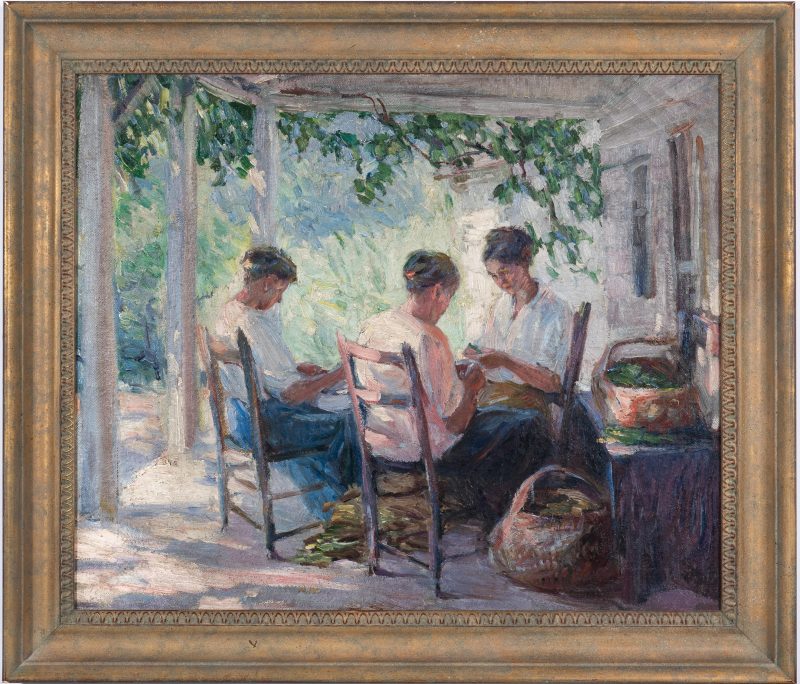 |
|
Anna Catherine Wiley (TN, 1879-1958), “The Pea Shellers” oil on canvas. Sight 19 1/2″ H x 23 1/8″ W. Framed – 24 1/2″ H x 28 1/2″ W. More information in the coming weeks. |
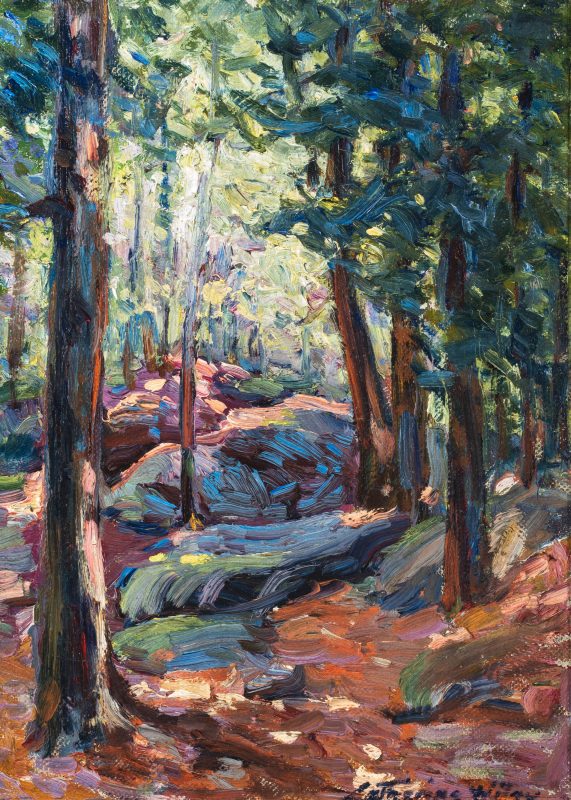 |
|
Anna Catherine Wiley (TN, 1879-1958) oil on canvas on board impressionist forest scene. Signed lower right “Catherine Wiley”. Housed in the original carved and painted frame. Additionally signed en verso on artist’s board label. Otto Hylen Company/ Nashville, TN label also en verso. Sight – 13 3/4″ H x 9 5/8″ W. Framed – 19 1/2″ H x 15 3/4″ W. Provenance: Originally from the collection of Thomas and Lola King, Nashville, TN. Descended through the family to the current owner. Artist’s Biography: Catherine Wiley is one of Tennessee’s most important nationally recognized artists. She was one of the early female students at the University of Tennessee, and was later credited with establishing formal art instruction at the school. Wiley studied at the Art Students League in New York under Frank DuMond, and spent summers learning from major American impressionists such as Robert Reid, Jonas Lie, and Martha Walter. She won numerous prizes including two Gold Medals at the Appalachian Exposition in 1910 and her paintings were exhibited at prominent American venues including the National Academy of Design in New York and the Pennsylvania Academy of Fine Arts. Her thriving career was ended by a mental collapse which left her institutionalized until her death. |
 |
|
Carroll Cloar (Tennessee, 1913-1993) acrylic on board painting titled “Black Angus” depicting six black cows in an orange/brown grassy field with barn and barren trees in the background, all under a bright blue sky. Signed, dated and titled en verso “Black Angus/Carroll Cloar/May 1967/Acrylic”. Housed in an ebonized and parcel gilt wood frame. Sight – 11 3/8″ H x 15 1/2″ W. Framed – 16 1/2′ H x 20 5/8″ W. Provenance: painting was given by the artist to a friend who lived in Memphis and has descended in her family.
|
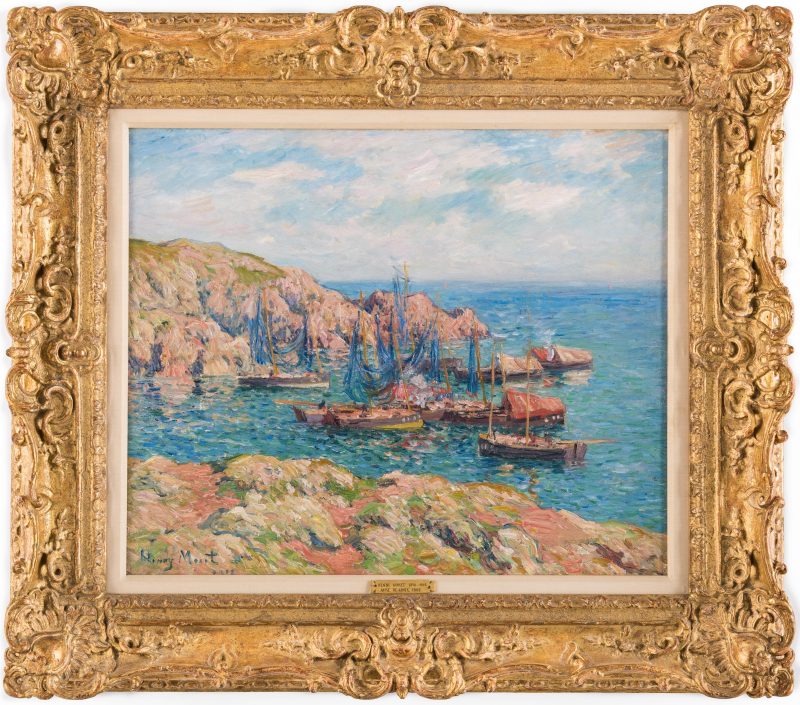 |
|
Henry Moret (France, 1856-1913), “Groix: Bateaux dans L’Anse,” oil on canvas coastal landscape depicting boats in a cove, as viewed from an overlooking cliff, all under a vivid blue sky with scattered white clouds. The impressionist style landscape is rendered in a thick impasto technique, in vivid shades of blue, pink and green. Signed “Henry Moret” lower left and dated, “1902”. Ornate Rococo style giltwood and composition frame with foliate and cartouche molding, pierced edges and plaque, lower center, with name of artist and title “Anse de Croix 1902”. Sight 19 1/2″ H x 23 1/2″ W. Frame 29 1/4″ H x 33 1/2″ W. More information in the coming weeks. Provenance: Private Nashville collection. |
 |
|
Leon Augustin Lhermitte (French, 1844-1925), oil on canvas painting of workers in a field; three women and one man harvest hay to build a haystack; more figures and haystacks are in the background, along with a hut set against a treeline, all under a mostly sunny sky. Signed lower left, L. Lhermitte. Housed in a giltwood molded Rococo style frame; plaque lower center with artist’s name and life dates. Sight 18″ H x 21 3/4″ W. Frame 27″ H x 31″W. Provenance: Private Nashville collection. |
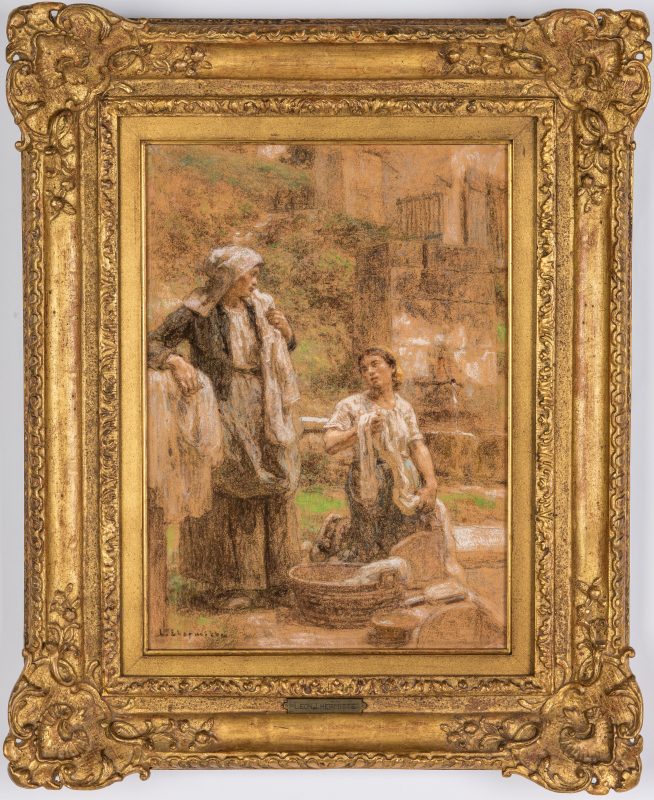 |
|
Leon Augustin L’Hermitte (French, 1844-1925), “Au Lavoir, Deux Figures,” or “The Washer Women, France,” graphite and pastel painting depicting two laundresses talking as they wash clothing, with village in background; one woman kneels beside a wash tub and holds a long white cloth in her hands, while the other stands with her elbow resting against a fence or wall. Signed lower left “L. Lhermitte”. Old label en verso for The Watson Art Galleries, Montreal, with statement of authenticity signed by Mr. Watson and listing title as “The Washer Women; France.” Additional handwritten note en verso “Lined by Frank Worrell April 25th 1964.” Housed under glass in a Rococo style carved giltwood frame with shell and vine decoration at corners and a center brass plaque engraved “Leon L’Hermitte.” 16 1/2″ x 11 1/2″ sight, 25 1/4″ x 20 1/2″ framed. Ref. Le Pelley Fonteny, Monique: “Leon Augustin Lhermitte: Catalog Raisonne,” Paris: Editions Cercle d’art, 1991, p. 65 no. 692. Provenance: Private Nashville, Tennessee collection; ex-Guarisco Galleries, Washington, DC. |
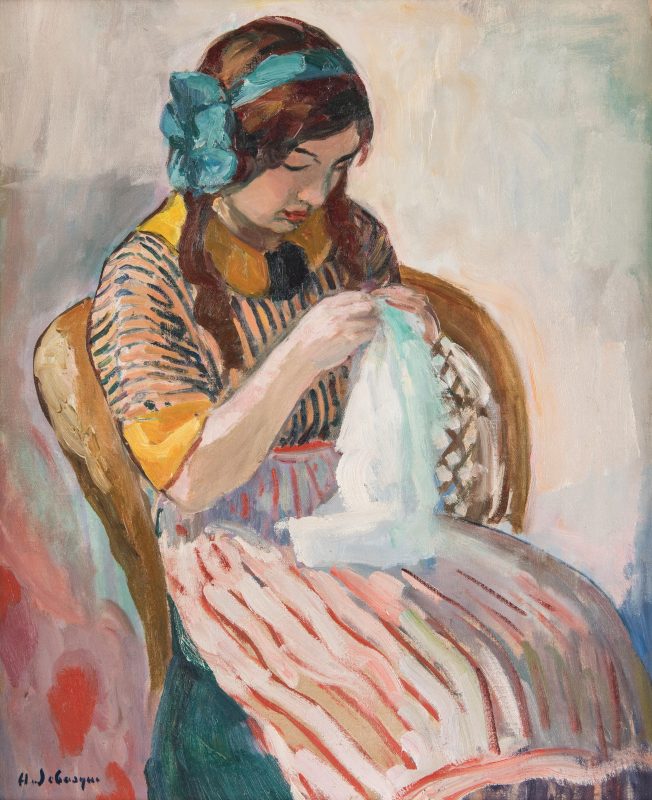 |
|
Henri Lebasque (French, 1865-1937) oil on canvas painting of a young girl wearing a pink and yellow dress and a blue bow in her hair, seated in a chair and looking down at a piece of fabric she is sewing. The background is comprised of colorful splashes of red, blue and gray. Signed “H. Lebasque” lower left. Hand carved gilt and white-washed frame. Guarisco Gallery, Washington DC label en verso of frame. Sight 21″ H x 17 1/2″ W. Frame 30″ H x 26 1/2″ W. Provenance: Private Nashville, TN Collection, ex-Guarisco Gallery. Ref. Henri Lebasque, Catalog Raisonne by Denise Basetoux, No. 673, p. 194. |
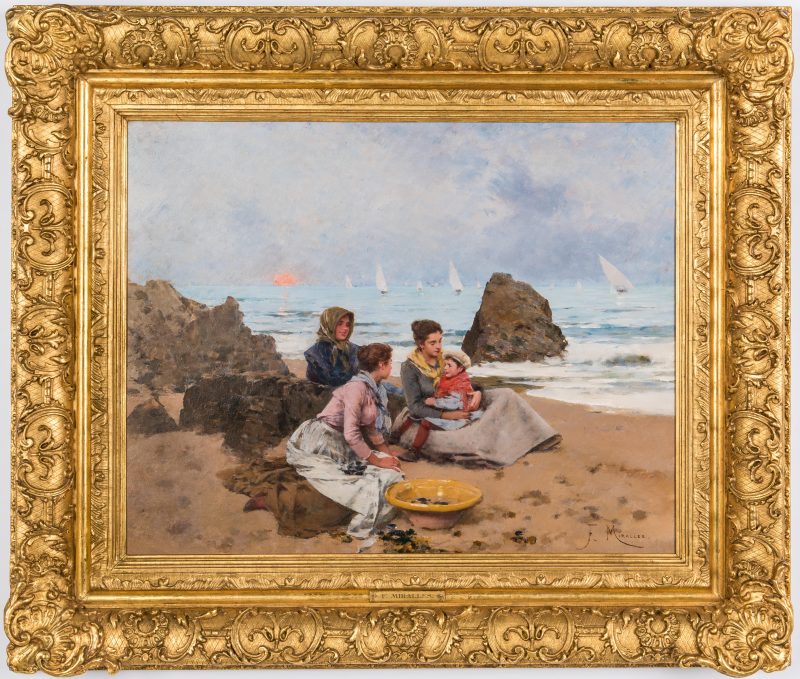 |
|
Francisco Miralles y Galup or Gallup (Spanish, 1848-1901) oil on panel painting depicting three women seated on a rocky beach; one is holding a young boy in her lap. A bowl of oysters or clams sits in the foreground, while boats sail past and the sun sets in the background. Signed lower right; brass name plaque affixed center of frame. Label en verso for J.B. Pares Gallery, Barcelona Spain along with small paper tag “No. 26”. Antique carved giltwood frame with cartouche and foliate scroll moldings, old paper label en verso of frame for Robert Macindoe, Framer, Gilder and Picture Frame Maker, Glasgow. 20 1/4″ x 25 3/4″ sight, 31″ x 36″ framed. Provenance: Private Nashville collection, ex-Mark Murray Fine Paintings, New York. |
 |
|
English oil on canvas mountain landscape by Alfred Fontville De Breanski, Jr. (1877 – 1957, United Kingdom) titled en verso “The English Lakes: Spring in the Langdale Valley”. Signed lower right and housed in a carved gilt frame. Additionally signed en verso. Sight – 23 1/2″ H x 35 1/4″ W. Framed – 31 5/8″ H x 43 1/2″ W. |
 |
|
Jean-Leon Gerome (France, 1824-1904) bronze sculpture depicting two jockeys on horseback in mid jump over a hedge. Signed “J L Gerome” left side of base, Siot Decauville Fondeur Paris foundry mark and numbered “58 I” back of base. 13 3/4″ H x 19″ W x 7 1/2″ D. French, late 19th/early 20th century. Provenance: the estate of Jane Dudley, Nashville, Tennessee and Palm Beach, Florida. |
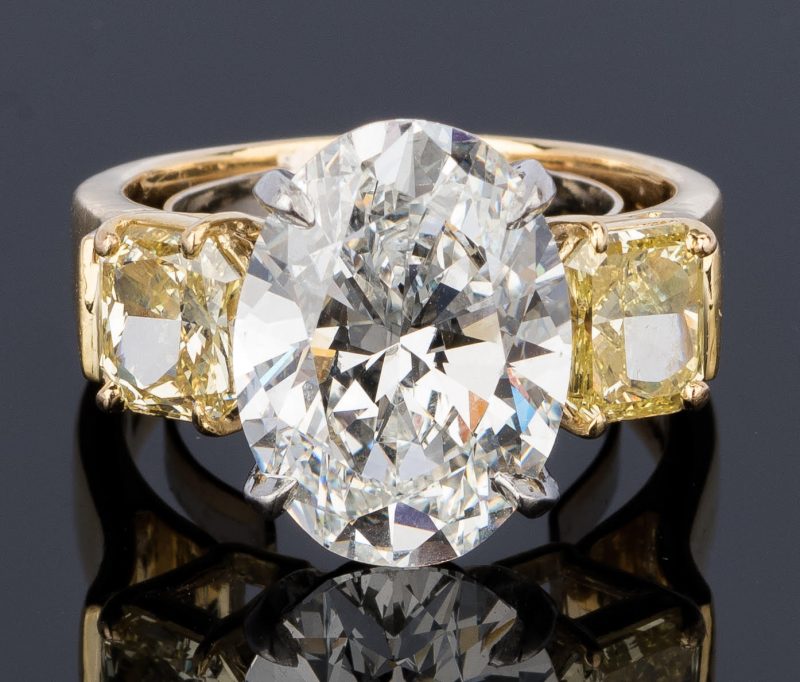 |
|
Three stone diamond ring containing one prong set oval shaped cut diamond, measuring 15.08 x 11.23 x 6.91mm, approximate weight 7.32ct., VS-1 clarity and G color, Excellent cut, 61.5% Depth, 57.0% Table, Excellent Polish, Excellent Symmetry. Two prong set radiant shaped cut diamonds, measuring 6.32 x 5.86 x 3.38mm, approximate total weight of 2 stones equals 2.05ct., VVS-1 Clarity, Fancy Dark Yellow Color, Very Good Cut, 87.7% Depth, 73.0% Table, Very good Polish, Very good Symmetry. Total weight of diamonds: 9.47 ct. Total weight of diamond engagement ring: 11.54 grams. Mounting is a stamped 18KT yellow gold lady’s combination cast and assembled 3-stone, cathedral style, diamond engagement ring with a soldered sizing bar with a polished finish. The center diamond is set in a 4-prong, platinum basket style setting identified with markings of “18K 950PT”. More information in the coming weeks. |
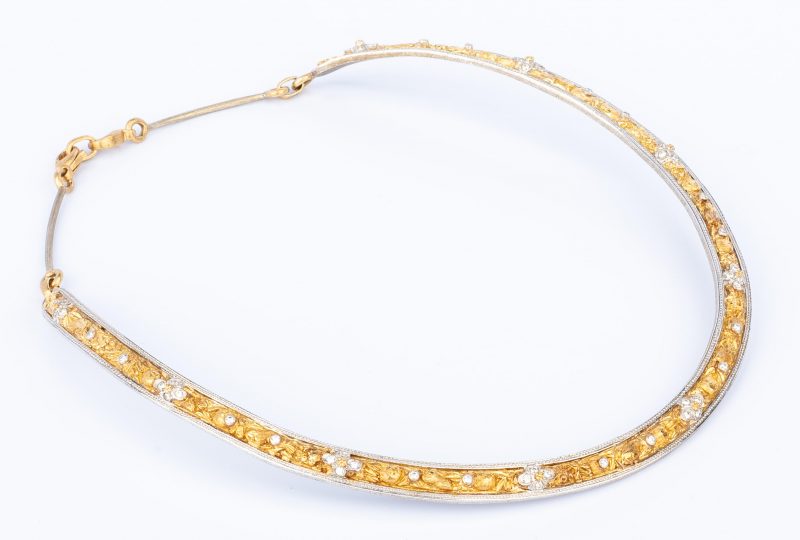 |
|
Federico Buccellati 18k white and yellow gold collar style diamond necklace with a gold cord and lobster style clasp. The collar portion with a 18k yellow gold flower and petal hand fabricated design containing 52 bezel/bead set round brilliant cut diamonds and all set in 18k white gold milgrain trim and backing. The fifty-two diamonds measure 1.70 – 1.60 x 0.99mm with approximate total weight of 0.85ct. (SI1 to SI2 clarity and G-H color). Signed FEDERICO BUCCELLATI. Marked 750. 8.47mm wide (5/16″). 19 inches total diameter. 100.70 grams. |
 |
|
Gents’ Rolex Submariner 18k yellow gold and steel watch, 40mm black bezel, black face with white enamel baton hour markers, manual movement, calendar date aperture at three, acrylic crystal. Serial # P987822, Style No. R16613N30B9325, Oyster Perpetual Date, Officially Certified Superlative Chronometer, black dial and bezel, 7 1/2″ interior circumference. Marked 93253 on bracelet. Manufactured in 2000. Retains original box, warranty, manual, anchor and red hang tags. Provenance: Private Knoxville, TN collector. |
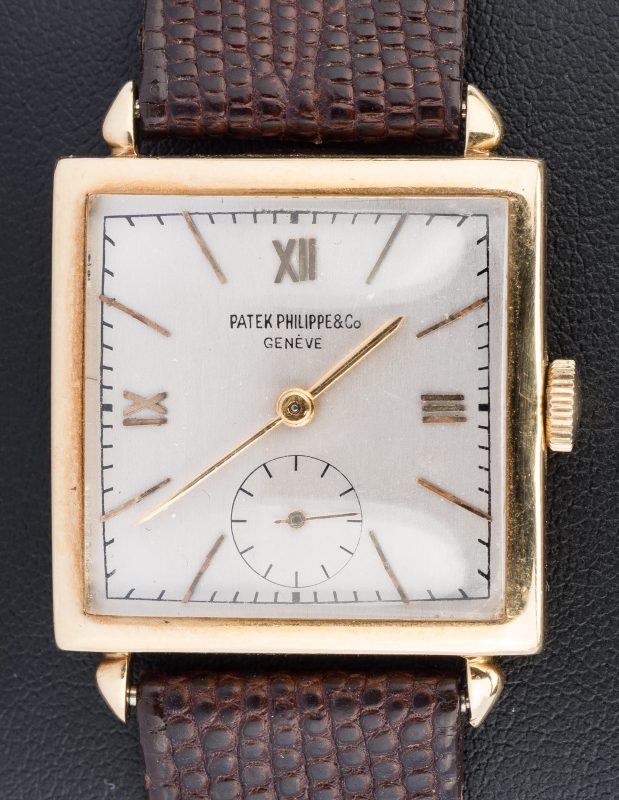 |
|
Patek Philippe 18k mechanical watch, square face, silvered face with secondary dial, 26 x 37mm, 18J, RF #1432, circa 1940s, brown band with 18k buckle. 8 7/8″ total length. |
 |
|
Tiffany & Co. 18k white and yellow gold “En Tremblant” hinged petal style diamond brooch/pendant containing one hundred sixty-eight (168) pave’ set round brilliant cut diamonds, measuring 2.30 – 1.40 x 1.11mm (depth estimate) with approximate total weight of 3.88ct. (VS clarity; F-G color). The mounting has a pin mechanism and hidden bail for vertical suspension. Pin mechanism is marked Tiffany & Co. 2-1/8″ x 1-5/8″. 26.7 grams. |
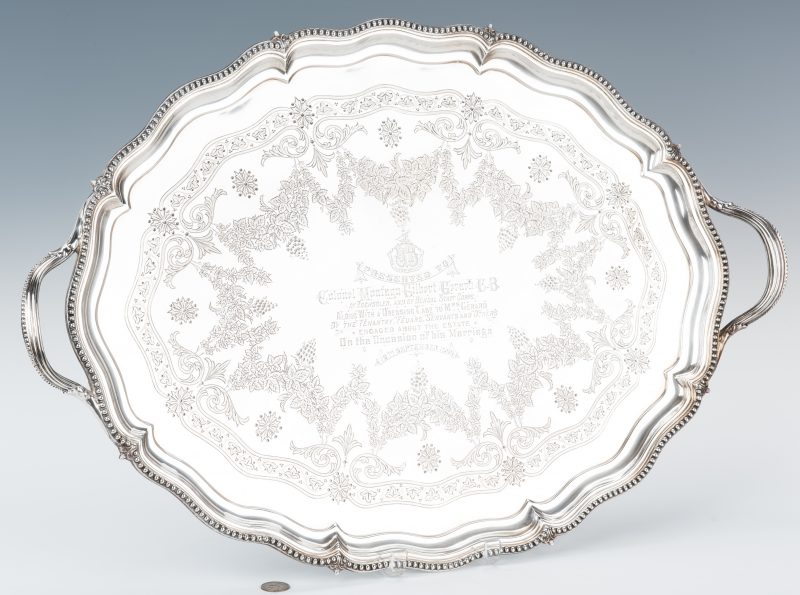 |
|
Victorian sterling silver presentation tray, maker’s marks for James Beebe, London, 1888. Oval, handled form with shaped beaded border and four acanthus leaf feet. Center with engraved grapevine decoration, coat of arms and presentation inscription reading “Presented to: Colonel Montagu Gilbert Gerard C. B./of Rochsoles, and of Bengal Staff Corps./Along with a Dressing Case to Mrs. Gerard/by the Tenantry Feuars, Servents & Others engaged about the estate/On the Occasion of his Marriage/19th September 1888”. 111.37 troy ounces. 18 3/4″ H x 27 7/8″ W. |
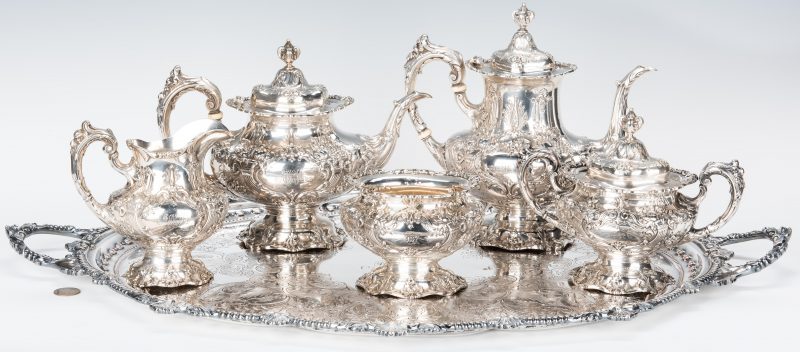 |
|
Five piece sterling silver vintage Reed & Barton Francis I pattern tea and coffee service consisting of coffee and tea pot, both with hinged lids and spacers, covered sugar bowl, cream pitcher and waste bowl, all with maker’s mark, Sterling, 570A and pattern name on base. Each piece with monogram AWM in one cartouche and date 1937 in opposite cartouche. 126.16 oz troy/ 5 pieces. Together with ornate Ellis Barker silver over copper tea tray, scalloped oval border with shell and gadroon pattern, monogrammed in center and dated on base, menorah mark, Birmingham, England, 20 1/4″ x 30″ including handles. |
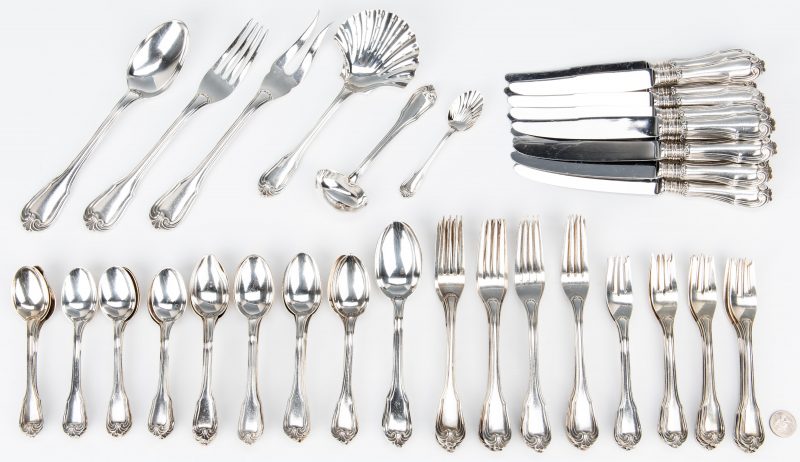 |
|
68 pieces Buccellati Borgia pattern sterling silver flatware, including 12 dinner knives (9 5/8″ L), 12 dinner forks (8 3/8″ L), 12 fish/salad forks (6 7/8″ L), 12 teaspoons (6 1/8″ L), 12 desert/place spoons, 2 table spoons, 1 serving spoon, 1 pierced vegetable serving spoon, 1 gravy ladle, 1 cold meat fork, 1 two tined serving fork, and 1 sugar shell spoon. Not monogrammed. 135.23 weighable troy ounces. |
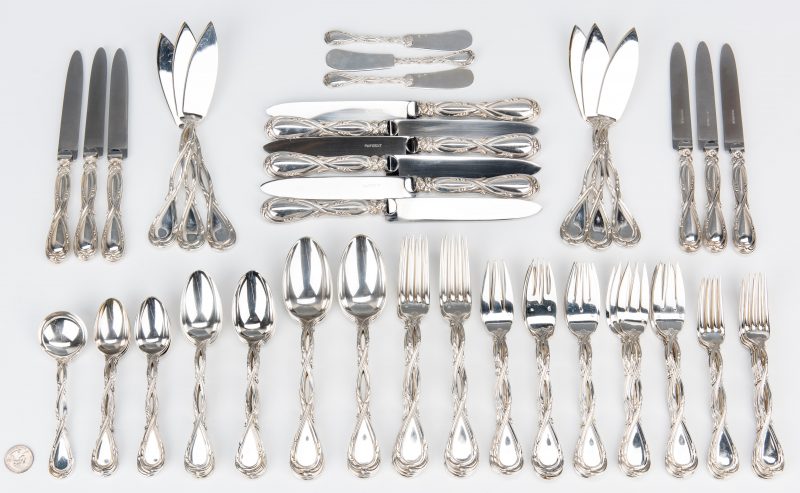 |
|
66 pieces French Puiforcat Royal pattern sterling silver flatware, including 6 dinner knives (9 7/8″ L), 6 dinner forks (8″ L), 6 salad forks (6 7/8″ L), 12 fish forks (7 3/8″ L), 6 teaspoons (5 7/8″ L), 8 dessert/oval soup spoons, 6 tablespoons, 1 jam/caviar/bouillon spoon, 6 fish knives, 6 dessert knives, and 3 flat butter spreaders. Not monogrammed. 120.88 weighable oz troy. |
 |
|
English sterling silver Rococo style tureen, lobed oval form; domed oval lid with removable loop handle, and repousse flower and cartouche decoration; small cutout in edge for a ladle handle (ladle not included). Conforming oval body with scroll border near lip, repousse flower and cartouche decoration with one cartouche enclosing a script monogram, the other a crest; ear-shaped handles with overlaid leaf decoration, all raised on a short, conforming pedestal foot with floral and cartouche decoration. Lid and base both hallmarked for Sheffield, Sterling, 1908 with maker’s mark for Martin, Hall & Co.; the body with additional stamped retailer mark, “Gibson Belfast.” 11 1/2″ H x 19 1/2″ W x 9 3/4″ D. 118.17 oz troy. Together with an associated Reed & Barton silverplate shaped oval undertray, marked 5105, 18, EPNS on base, 19 1/8″ x 13 1/2″ x 7/8″ H. |
 |
|
Large Dominick & Haff 6-pint sterling water pitcher, pattern #1410A, having a scroll and shell shaped border, floral repousse and engraved decoration to the body with two reserves and shaped handle, over a shaped scroll and shell base, marked on the base; together with twelve (12) pattern #S6393 water goblets having raised floral reserved decoration to the bowls and shaped scroll and shell feet, marked on the bases. No monograms to any pieces. Pitcher measures 8 3/4″ H x 12″ dia. and weighs 41.835 troy ounces. Goblets measure 5 3/4: H and weigh 56.447 troy ounces. 98.312 total troy ounces. |
 |
|
Edgefield District, South Carolina stoneware alkaline pottery face jug, made at the Thomas Davies Factory (1861-1864) by an unknown African American maker. Light to dark olive green alkaline glaze with kaolin eyes and teeth, wide set eyes, singular eyebrow and large nose. 4 3/4″ H x 4 1/4″ dia. More information in the coming weeks. |
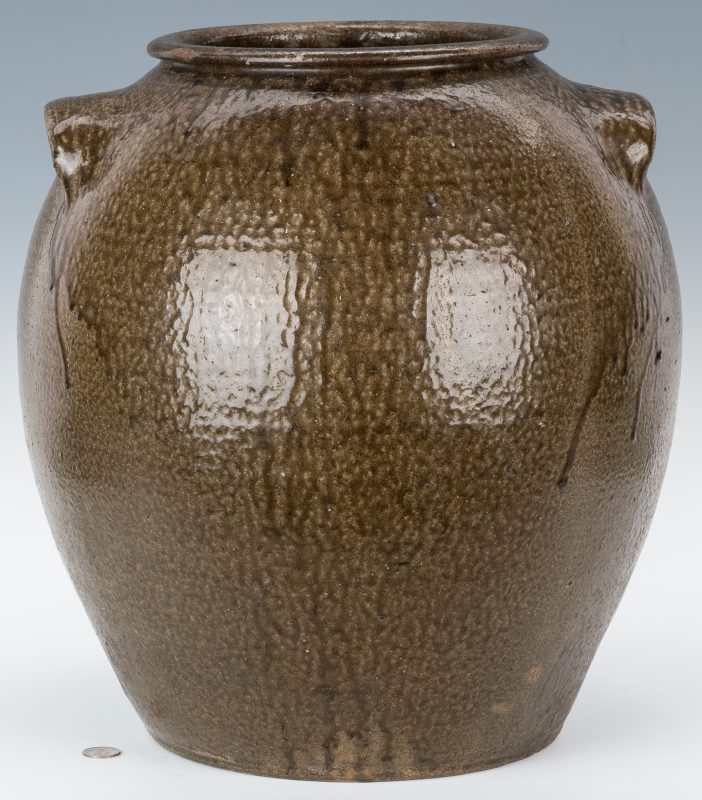 |
|
Monumental North Carolina, Catawba Valley, 10-gallon alkaline glaze pottery storage jar. Ovoid form with lug handles and slightly rolled rim, dark olive alkaline glaze. Stamped on one handle “DS” for Daniel Seagle (1805-1867) and “10” on one handle denoting capacity. 17 3/4″ H x 15 3/4″ dia. More information in the coming weeks. |
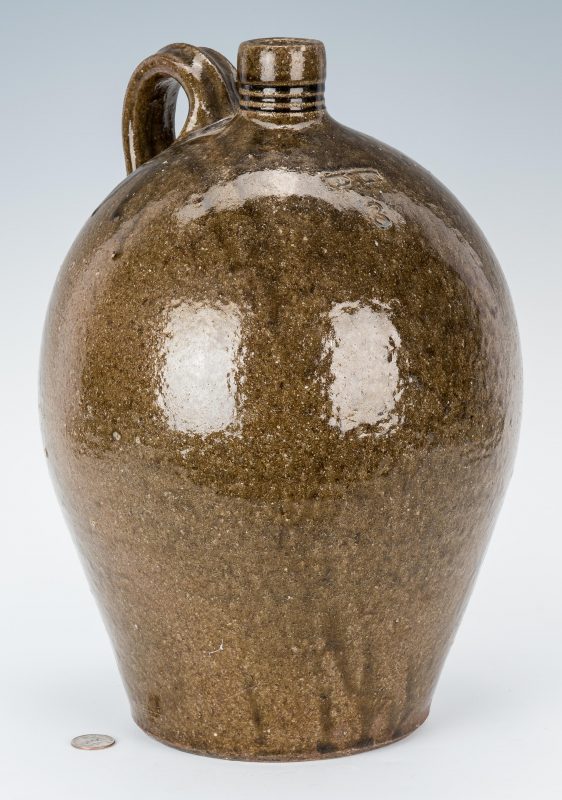 |
|
North Carolina, Catawba Valley, alkaline glazed stoneware pottery jug, ovoid form with strap handle, incised lines below the spout. Upper shoulder beneath spout with incised initials “DS” for Daniel Seagle (1805-1867) and a “3” denoting capacity. 15″ H. Mid-19th Century. |
 |
|
East Tennessee lead glazed earthenware jar with manganese splotched decoration, pulled loop handles, rim and upper shoulder with incised concentric lines, unglazed base with beaded foot. 15″ H. For a closely related form, refer to the article, “Earthenware Potters Along the Great Road in Virginia and Tennessee”, J. Roderick Moore, Antiques Magazine, September 1983, p. 532, plate IV. This form is one of the largest found from this group. Provenance: Descended through the Bireley Estate, Hamblen County, Tennessee. |
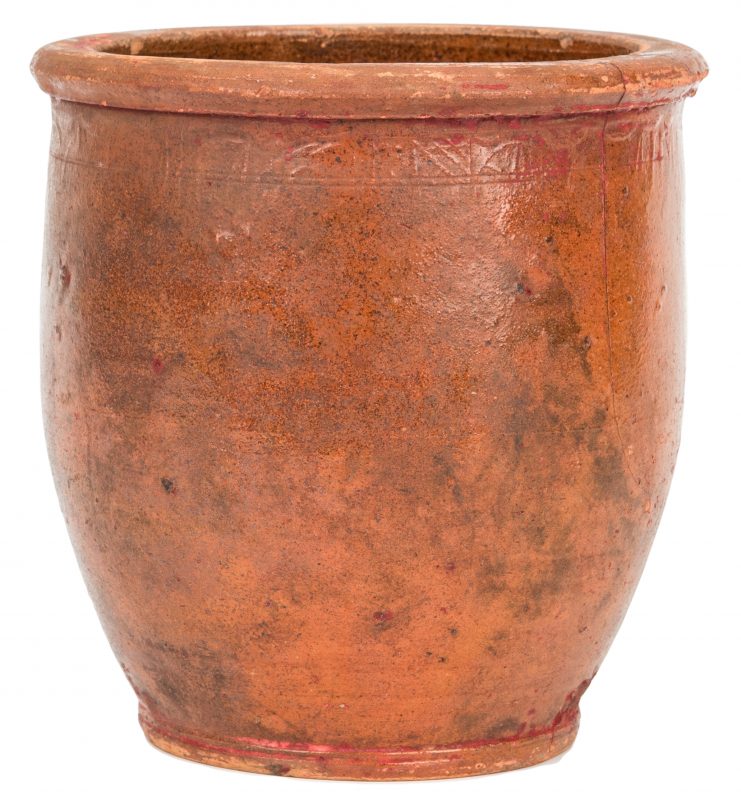 |
|
East Tennessee, Greene County, earthenware pottery cream pot by Christopher Alexander Haun (1821-1861), Greene County, Tennessee. Coggled band underside rim with stylized lettering and geometric stamps. 5 3/4″ H. Historical Note: Christopher Alexander Haun was a Union sympathizer during the Civil War and participated in burning a Confederate railroad bridge (Lick Creek) in Greene County, TN. This important event in East Tennessee’s Civil War history was initiated with a campaign by Union loyalists to burn 9 bridges. It was led by William B. Carter and strongly supported and encouraged by President Abraham Lincoln. Several potters from the Pottertown, TN area were among the men who conspired and succeeded in burning the bridge. The potters decided not to capture or kill the Confederate bridge guards but allowed them to go free based upon their solemn promises to not reveal their identities. Union troops did not materialize as promised, and the Confederates were able to pursue and capture some of the perpetrators. The Confederate guards, who were allowed to live, were the very ones who served as witnesses to implicate the five men who were hung, four of them potters. Among those sentenced to hang was the potter Christopher Alexander Haun. In his last hours, Haun wrote to his wife and said “have Bohanan, Hinshaw or Low to finish off that ware and do the best you can with it for your support”. On December 11th, 1861, Haun was hung from the gallows in Knoxville, TN. |
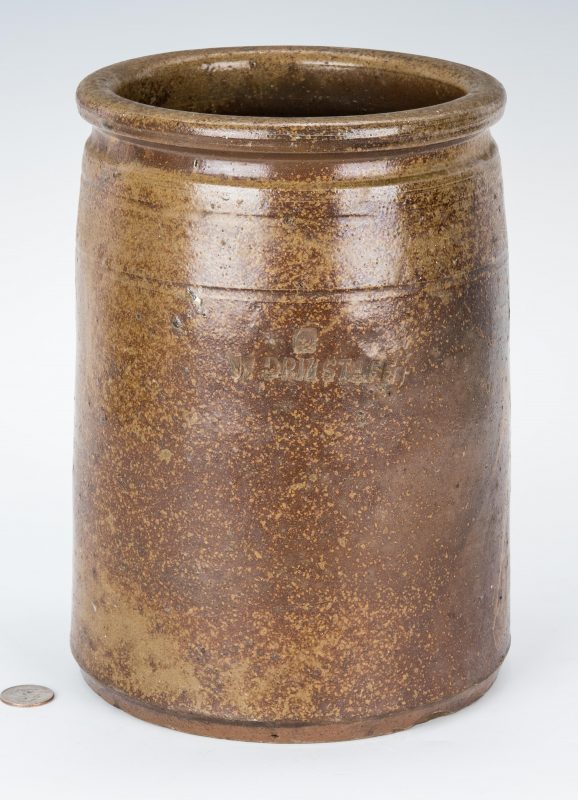 |
|
East Tennessee, Blount or Knox County, stoneware pottery preserving jar, with 2 incised lines around the shoulder. Upper body with impressed semi-circle stamp “W. Grinstaff” for William Grindstaff, with an impressed “2” above denoting capacity. 10 5/8″H. Late 19th century. |
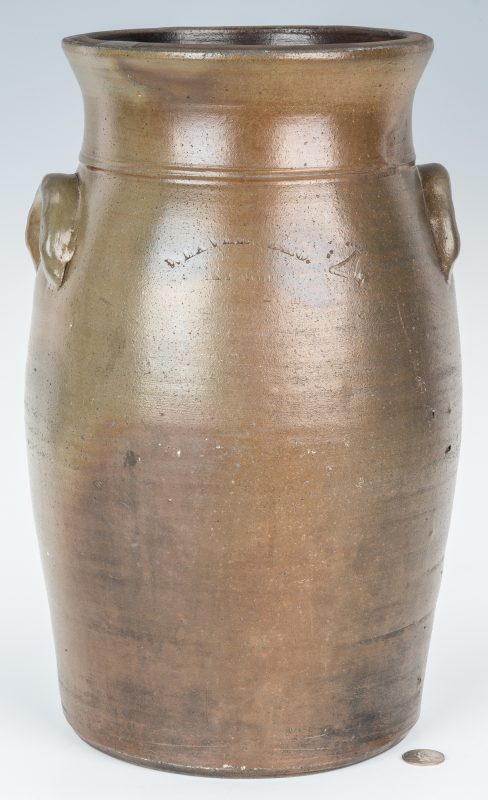 |
|
East Tennessee, Knoxville, Tennessee Weaver Brothers stoneware pottery jar with elongated rim and lug handles and stamped “Weaver & Bro., Knoxville, Tenn.” and “4” denoting capacity . The Weaver Pottery was listed in the Knoxville Business Directory from 1876-1887 with David Weaver listed as the proprietor and George C. Weaver as a potter. (Survey Of Historic Pottery Making In Tennessee 1979″, Division Of Archeology, Tennessee Department Of Conservation, Smith And Rogers). 16″ H. |
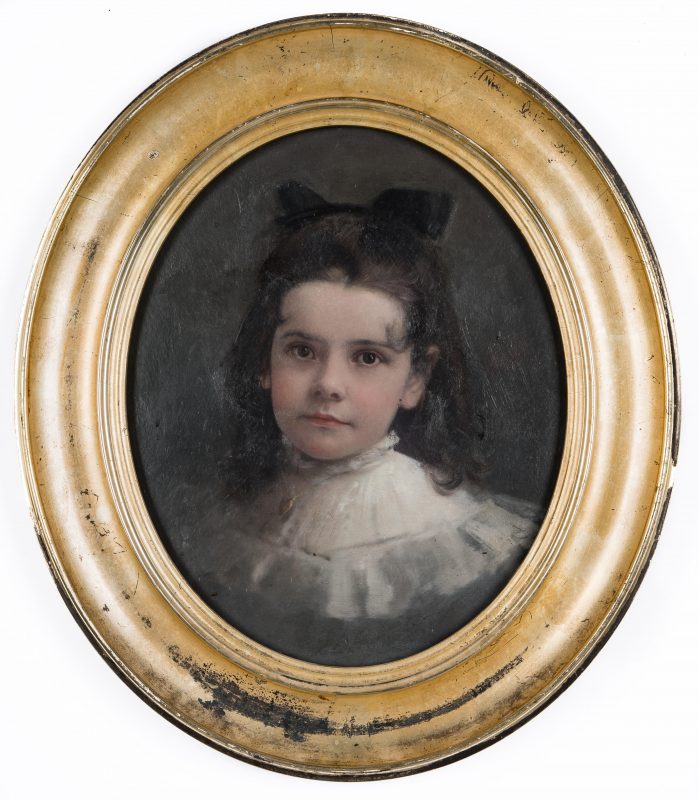 |
|
Lloyd Branson (Tennessee, 1861-1925) oil on board of his niece, Susan Williams Branson (1892 – 1901). Subject is attired in a white dress with gold locket. Susan was a child musical prodigy and played the violin. She died of diphtheria when she was 9 years old. Possibly signed and dated upper left margin. Portrait is likely posthumous after a photograph. Housed in an oval gilt wood frame. Board – 17″ H x 13 3/4″ W. Sight – 16 3/8″ H x 13 3/8″ W. Framed 23 3/4″ H x 20 1/2″ W. |
 |
|
William Wendt (American/California, 1865 – 1946) large plein-air impressionist oil on canvas landscape titled “Breezy Uplands” depicting a lush green pasture with a copse of trees to the right under a cloud filled sky. Signed lower right “W. Wendt”. Housed in an elaborate, possibly original gilt and gesso rococo style frame. Sight – 19 3/4″ H x 35 3/4″ W. Framed – 33 1/2″ H x 48 5/8″ W. Provenance: the estate of Mrs. Frank Wood, Evansville, Indiana and Dickson, Tennessee; acquired 1981 from the estate of Dalton Jobe of Indiana. |
 |
|
Adelia Armstrong Lutz (American/Tennessee, 1859-1931) large oil on canvas after the original by William-Adolphe Bouguereau (French, 1825-1905) titled “The Little Knitter”. Painting depicts a young dark haired European peasant girl sitting on a terrace with flowers and village visible to her left. Signed lower right of girl “After Wm Bouguereau/ A.L.”. Housed in a heavily carved and layered giltwood frame. Sight 44 3/4″ H x 31 1/4″ W. Frame 60″ H x 46″W x 7″D. Provenance: Property of a direct descendant of Adelia Armstrong Lutz. Artist’s Biography: Adelia Armstrong Lutz (1859-1931) was known for painting portraits, landscapes, and still lifes. She was born in Jefferson County, Tennessee. She studied art at the Corcoran Gallery in Washington, D.C., at the Pennsylvania Academy of Fine Arts, and abroad. Upon her return to Knoxville in 1887, she was a director of the Knoxville Art Club and co-organized the Nicholson Art League. She married John Edwin Lutz in 1885 and they built their home, “Westwood”, on Knoxville’s Kingston Pike in approximately 1890. |
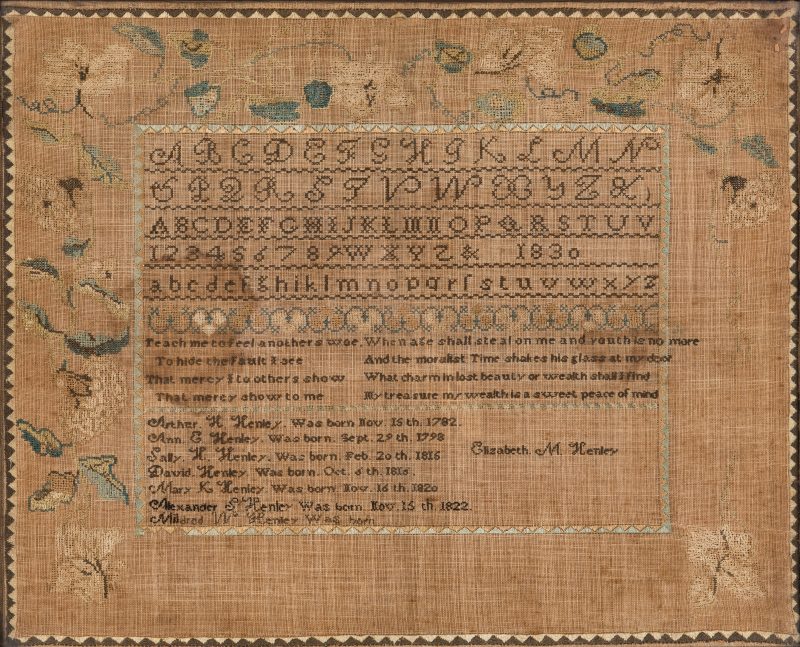 |
|
Tennessee needlework Family Register sampler, worked 1830 by Elizabeth M. Henley at the Knoxville Female Academy. Elizabeth Henley, granddaughter of Revolutionary War hero Col. David Henley, married Barclay McGhee, grandson of Knoxville settler and politician Col. Charles McClung. Silk on linen sampler with wide floral border, partially unfinished, with zig zag design satin stitch edging in contrasting light and dark threads, enclosing three rows of cross-stitched alphabet, the date 1830 and a row of numbers, over a bud and heart-with-cross motif band, over two verses: “Teach me to feel another’s woe/To hide the fault I see/that Mercy to others show /that mercy show to me” and “When age shall steal on me and youth is no more/and the moralist Time shakes his glass at my door/ What charm in lost beauty or wealth shall find/ my treasure my wealth is a sweet peace of mind.” Below the side by side verses is Elizabeth M. Henley’s signature and a family register with names and birth dates of her father, Arthur H. Henley, born Nov. 15, 1782; mother Ann E. Henley born Sept. 29, 1798, and siblings and/or possibly cousins: Sally H. Henley, born Feb. 20, 1816; David Henley, born Oct. 5, 1816; Mary K. Henley born Nov. 16, 1820; Alexander S. Henley born Nov. 15, 1822; and Mildred W. Henley (no birth date stated). 17 1/2″H x 21 3/4″ W sight; 19 1/2″H x 23 3/4″ W framed. Note: This sampler has been documented by the Tennessee Sampler Survey. Elizabeth Henley was born Jan. 16, 1819 in Monroe County, Tennessee to Arthur and Ann Henley. Her grandfather on her father’s side, David Henley, was a Continental Army officer during the American Revolutionary War, who served as George Washington’s intelligence chief and prisoner of war commandant. He later served as the Agent for the United States War Department for the Southwest Territory (later Tennessee) in the 1790s. Elizabeth’s name appears in the Knoxville Female Academy catalog for 1831 along with that of her sister Mary, and was likely worked while she was attending this school in Knox County. Sadly, Elizabeth did not live long enough to reach the old age to which she alluded in her verse. She married Barclay McGhee in 1843 and died the following year at the age of 25, likely while giving birth to their son Robert (birth/death dates unknown). Barclay McGhee was the son of John Charles McGhee and Elizabeth Betsy Jones McClung McGhee (daughter of Knoxville settler and surveyor Colonel Charles McClung (1761-1835)); he also was known as the master of land his family owned on the prehistoric Native American site in Monroe County called Toqua. Three years after Elizabeth’s death, Barclay married her sister Mary (whose name appears on the sampler). Barclay died in 1856 at the age of 32. His cause of death was listed as a slit throat! |
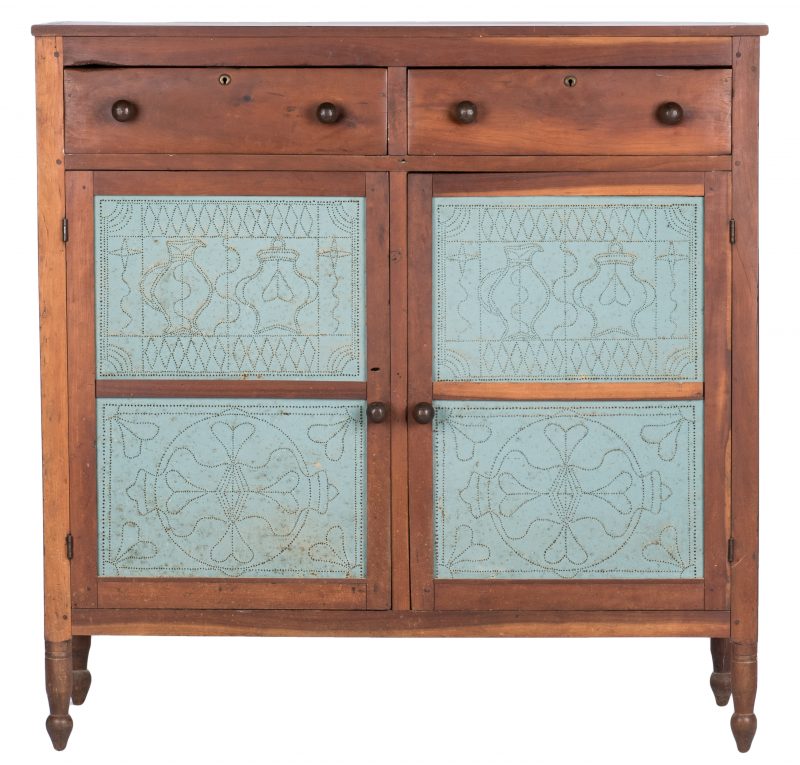 |
|
East Tennessee or Southwest Virginia pie safe, cherry primary, poplar secondary. Comprised of a slightly overhanging top above two dovetailed drawers with unusual domed wood pulls above two doors, each fitted with two blue painted punched tins and wood pulls. Upper door tins with pitcher, urn and star designs and the lower door tins with geometric circle with corner hearts punched tins. Sides fitted with larger geometric circle with corner hearts punched tins, all resting on turned legs. 48 1/2″ H x 48 1/2″ W x 18″ D. Possibly Sullivan Co., TN or Washington Co., VA. 3rd quarter 19th century. Estate of John Moran, Hayters Gap, Virginia. |
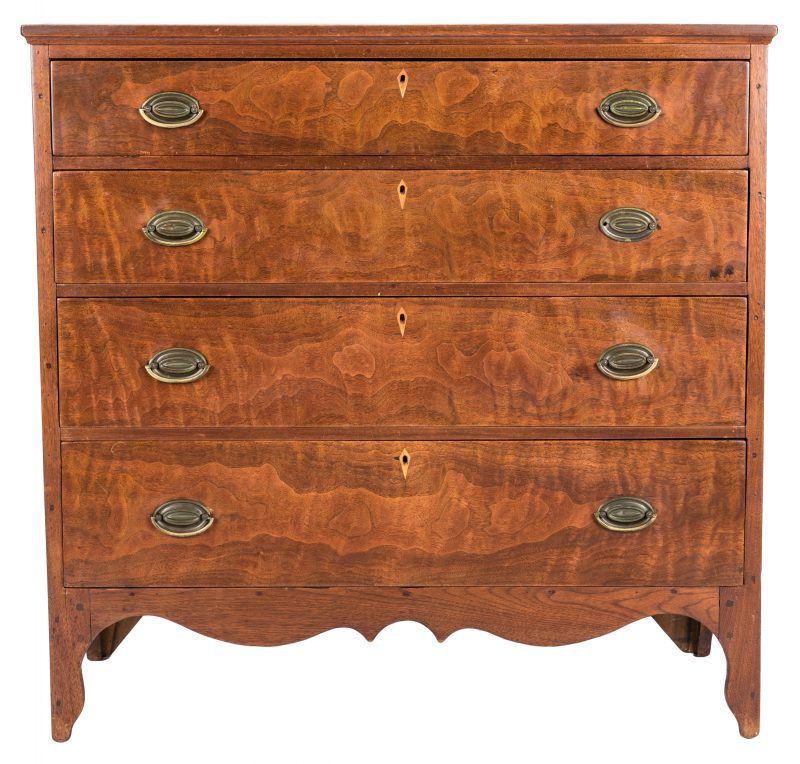 |
|
East Tennessee, Grainger or Greene County, Hepplewhite walnut chest of drawers. Highly figured walnut primary, poplar secondary. Comprised of a plain rectangular top, four graduated dovetailed drawers, inlaid escutcheons, shaped apron, and French feet. 38″ H x 38 3/4″ W x 17 3/4″ D. Circa 1820. Descended from Franklin William Taylor (1810-1886) of Grainger Co., TN, grandson of Daniel Taylor (1761-1834). In 1844, Franklin acquired Deadrick Plantation near Russellville and renamed it “Greenwood”. The home served as headquarters to Confederate General Joseph Kershaw in the Civil War. |
 |
|
Middle Tennessee Sheraton sugar chest, cherry primary, poplar secondary. Attributed to Davidson Co., TN. |
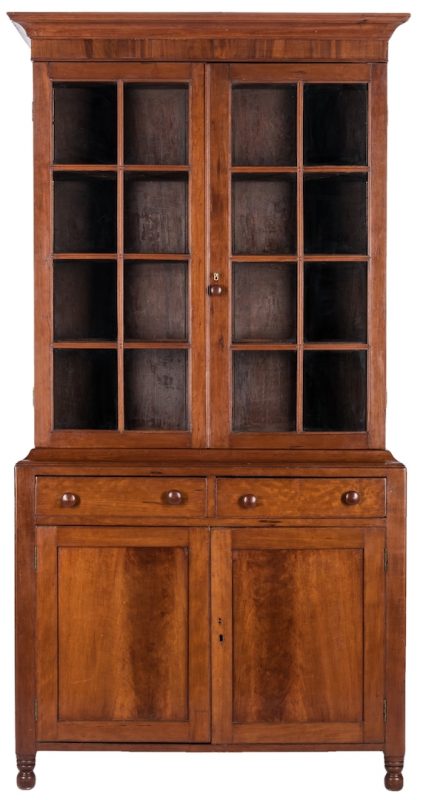 |
|
Sumner County, Tennessee Jackson Press, cherry primary with cherry and mahogany veneers, poplar secondary wood. Three piece construction: top section with cove molded cornice over mahogany veneered dovetailed frieze, second section with two glazed doors having 16 panes, brass escutcheons and hinges, opening to interior with three fixed shelves. Lower section with wide ogee molding at top to conceal the joinery of top and base, two scratch beaded dovetailed drawers with round wooden knobs, over two paneled doors enclosing an interior with single fixed shelf. Paneled sides on lower section, ring turned feet. 89″H x 45″W x 20″D. Second quarter 19th century. Provenance: Descended in a Middle Tennessee family. For examples of two nearly identical forms, see Lot 135 in our January 23, 2016 auction (descended in the family of Major William Lauderdale, of Trousdale County (formerly Sumner Co.), TN. and lot 206 in our Jan. 23, 2010 auction (descended in the Gwin family of Sumner County). |
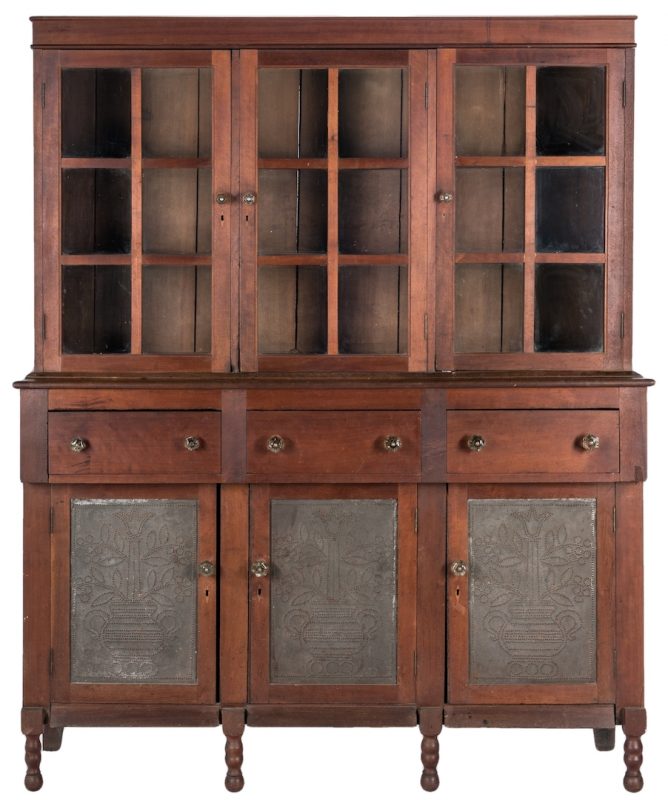 |
|
Southwest Virginia, Lee, Russell, or Scott County, two-piece pie safe and sideboard press, cherry primary, poplar secondary. Top comprised of a conforming removable cornice (dovetailed) over three doors having six glass panes. Base with three overhanging dovetailed doors over three doors with urn and polkberry tins and additional urn and polkberry tins to the sides. Resting on four turned front feet and two bootjack rear feet. 66 1/2″ W x 19″ D x 81 3/4″ H. 3rd Qtr. 19th century. |
 |
|
Thornton Dial (Alabama, 1928-2016) folk art watercolor and graphite on paper painting titled “Toll Bridge” depicting figures on both side of an abstracted bridge over bright blue water. Initialed “TD” lower right. Handwritten note reading “Toll Bridge:/If you got to cross the waters,/you got to pay the toll./1992″ attached en verso. Float mounted and matted under glass in a gilt silver frame with carved line running pattern. Sight – 29 1/2″ H x 41 3/4″ W. Framed – 40″ H x 52” W. American, late 20th century. More information in the coming weeks. |
 |
|
Clementine Reuben Hunter (Louisiana, 1886-1988) oil on canvasboard folk art painting titled “Going to Church” depicting African American figures with flowers coming to and from a church, top right, a funeral scene along the lower register, the grave rendered in a heavy impasto technique. Initialed “CH” center right. Housed in a carved giltwood frame with tan linen rabbet edge. Sight – 17 3/4″ H x 23 5/8″ W. Framed – 23 5/8″ H x 29 3/4″ W. American, mid/late 20th century. |
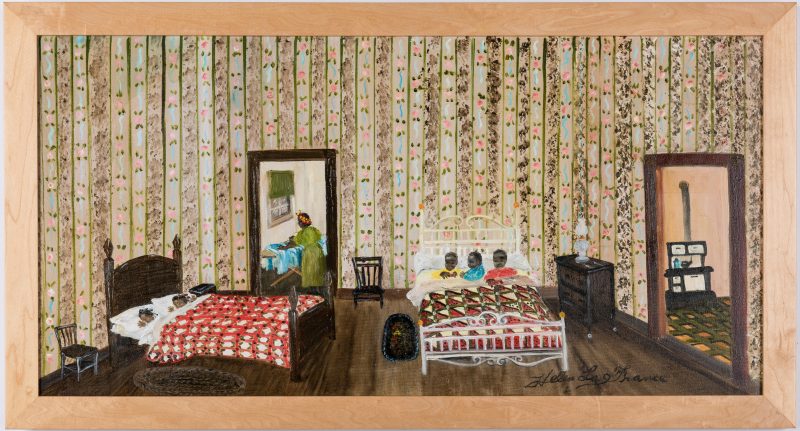 |
|
Helen LaFrance (Kentucky, b. 1919) oil on canvas painting depicting the interior of a bedroom in an African American home with vivid floral wall paper and two large quilt covered beds, one with three girls and one with two girls, their mother ironing clothes in the back left room, a kitchen with an old fashioned oven in the back right room. Signed lower right. Housed in a wooden frame. Sight – 17 1/2″ H x 35 1/2″ W. Framed – 21″ H x 38 5/8″ W. |
 |
|
Alfred Heber Hutty (Charleston, South Carolina, 1877-1954), drypoint etching titled “Discussion Group in Carolina”. Depicting a group of women harvesting or filling crates in the foreground and conversing with one another in an open field, trees in the background. Pencil signed Alfred Hutty lower right with snail monogram, additionally pencil signed “2nd state” in lower left. Circa 1946, Plate size 8 3/8″ x 12″, sight 8 3/5″ x 12 1/2″, framed 16″ x 20″. |
 |
|
Thomas Hart Benton (American, 1889-1975) lithograph on paper, “The Corral.” Pencil signed and signed in plate lower right. Likely from the edition of 250 published by Associated American Artists, New York. Matted and framed under glass in an ebonized molded frame. Image 9 1/2″ x 13 3/4″. Paper: 12″ x 16″ Frame: 17 3/4″ x 21 3/4″. Provenance: private Nashville collection. |
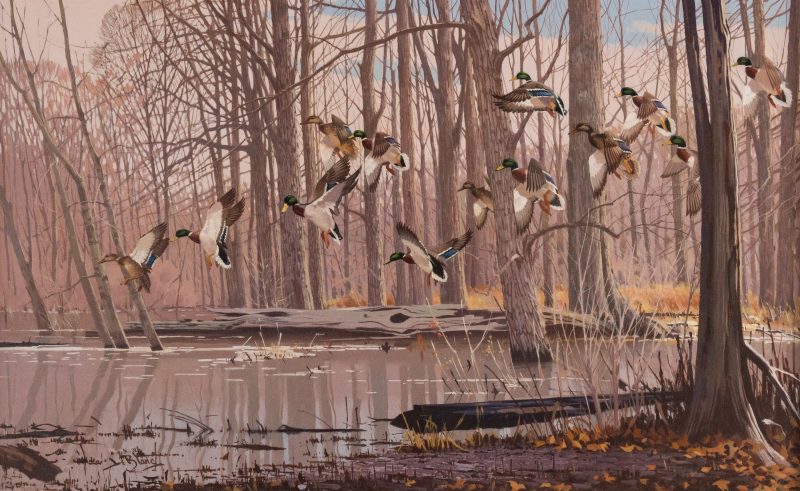 |
|
Lee LeBlanc (1913 – 1988/Michigan, California) large oil on canvas landscape depicting mallards at take off in a wooded landscape setting. Signed lower left “LeBlanc”. Housed in a rustic wood frame with linen liner. Sight – 25 1/2″ H x 41 1/4″ W. Framed – 31 5/8″ H x 47 5/8″ W. Artist Biography (Adapted from AskArt/Crocker Art Museum Store): Lee leBlanc was an illustrator and commercial artist. He studied in Los Angeles at the Chouinard Art School and Philadelphia Academy of Art before joining the staff at Disney Studios. He later held administrative positions at 20th Century Fox and MGM until his retirement in 1962. He then moved to Iron River, Ml where he remained. In 1972 he began designing stamps for wildlife and fishing licenses and won the federal duck stamp competition in 1973. Provenance: Acquired at a Oakland Chapter of Ducks Unlimited event in 1978 at the Pontiac Silverdome in Michigan. Artist was present at the event. |
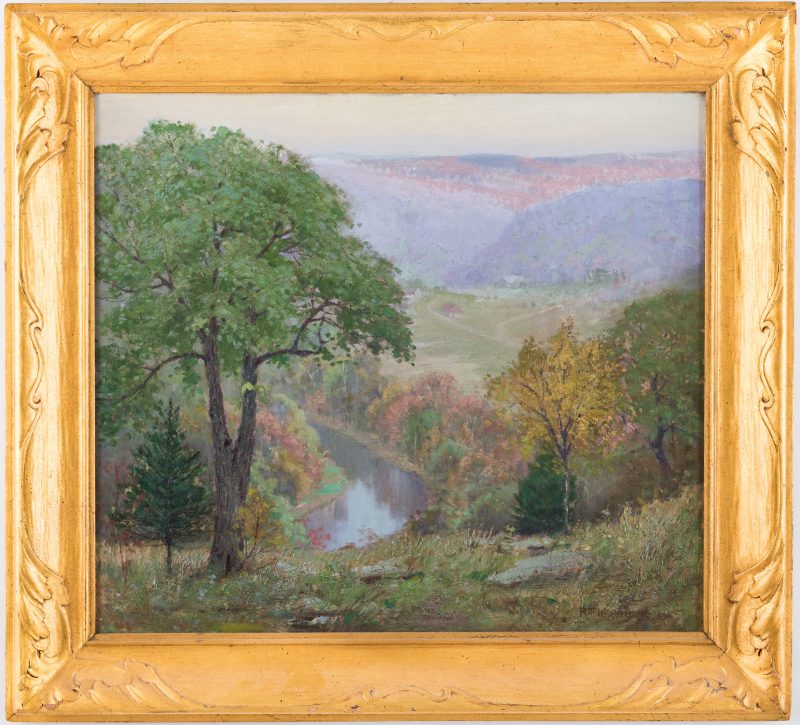 |
|
Rudolph Ingerle (American, 1879-1950) “The Fascinating Ozarks” oil on canvas landscape painting depicting a hillside with trees in the foreground, a still creek with a tree lined embankment and field with houses in the middle ground, and a range of pink and purple mountains in the early morning, background. Signed “R. F. Ingerle 15″ lower right. Titled verso. Housed in giltwood molded frame with acanthus carvings at corners. Sight – 23 3/4″ H x 26 7/8″ W. Framed – 31 3/4″ H x 34 1/2” W. Early 20th century. |
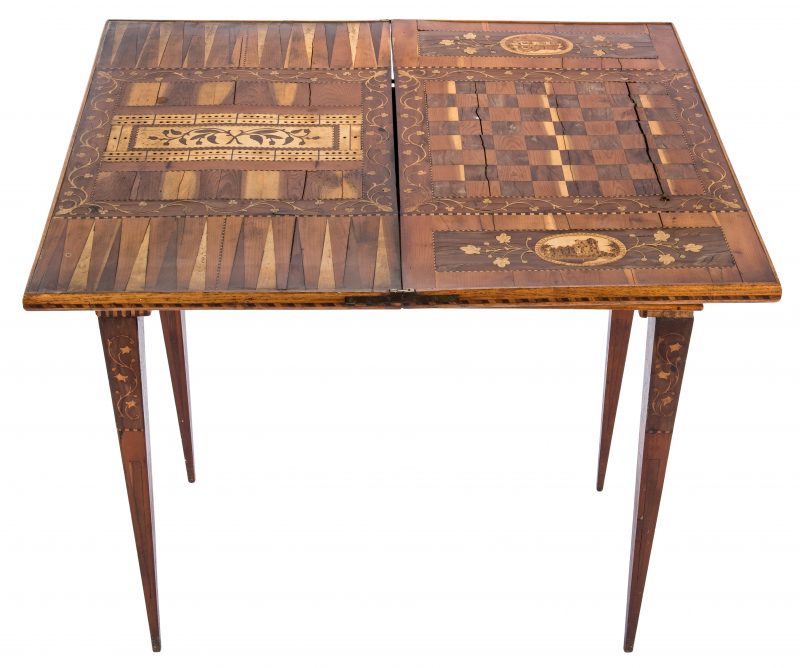 |
|
Elaborately inlaid Killearney, Ireland game table, arbutus and walnut with possible other mixed woods and contrasting inlays, mid 19th century. Rectangular top with central pictorial marquetry depiction of Muckross Abbey, Killearney within an oval cartouche bordered in herringbone inlay and enclosed within a wider foliate and cartouche border with herringbone edging; contrasting “barber pole” inlay to edges of top; frieze inlaid with oak leaf and acorn designs issuing from opposing dolphin heads at center; square tapered legs inlaid with trailing leaf/vine and contrasting block inlay at tops and tapering triangle or icicle inlay to the lower halves; leg inlay repeats on all legs on all sides. Top lefts to reveal a marquetry and parquetry interior with cribbage board enclosed within a leafy vine border and flanked by backgammon-design ends; center of cribbage board signed “Made in the Gap of Dunloe Killearney”. Opposing leaf contains a checkerboard within leafy vine and barber pole inlaid borders, flanked by pictorial inlaid vignettes of Glena Cottage and Ross Castle. 30 1/2″H x 31 1/2″ W x 17 1/2″D. |
 |
|
18th century oil on canvas portrait of a Spanish Colonial officer, possibly a member of the viceroyalty, depicted standing and attired in his military dress uniform with sash belt and sword, medal with ribbon around his neck. Subject holds a letter in one hand reading: “Prospecto para mejorar de sueldos a los Individuos de la real casa de Moneda de Santafe” – prospect to improve the salaries of the individuals of the royal mint of Santafe (Bogata, Columbia) and a cane in the other. Coat of Arms upper left corner reading “Armas de los Henriquez de Guzman”. Housed in a gilt carved rococo style frame with corner and side adornments. Sight – 34″ H x 26 3/4″ W. Framed – 45 1/2″ H x 38″ W. |
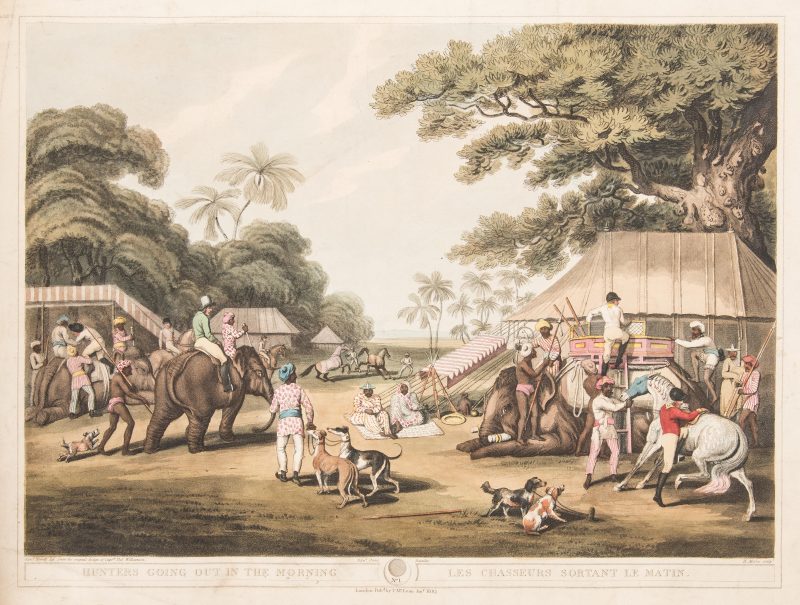 |
|
Oriental Field Sports of the East; Being a Complete, Detailed, and Accurate Description of the Wild Sports of the East, Second Edition, taken from the manuscripts and designs by Captain Thomas Williamson, drawings by Samuel Howitt, 1819. Printed by B. R. Howlett for Thomas McClean, London. Oblong folio, 145 marble edged pages with index, 40 hand colored aquatint plates after Samuel Howitt (from sketches by Williamson) by H. Merke, J. Hamble, and Vivares, hand painted half title page, rebound in three-quarter black pebbled leather with green pebbled leather sides, gilt lettering to spine, five raised hubs, marbled end papers. 17 1/4″ H x 22 5/8″ W x 1 3/4″ D. |
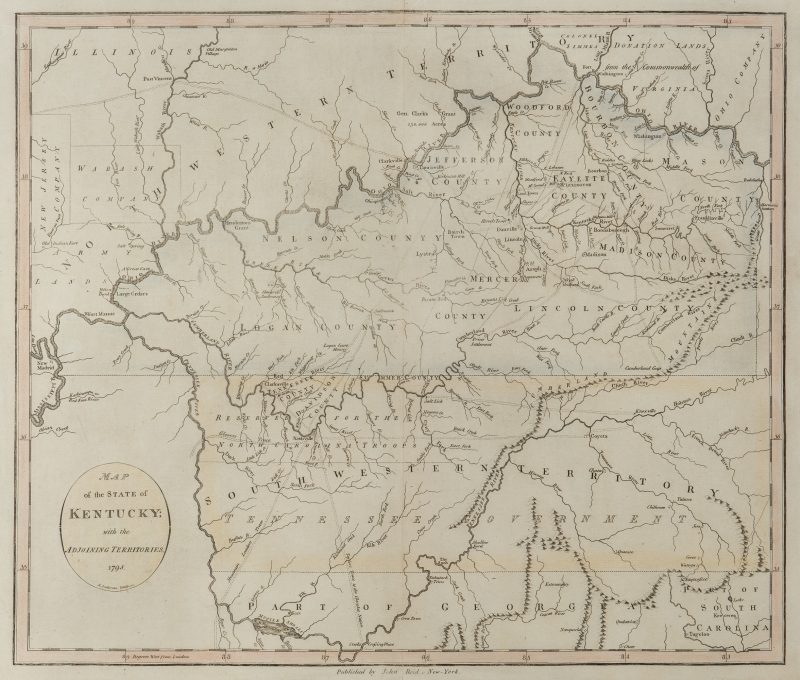 |
|
Map of the State of Kentucky with the Adjoining Territories 1795 engraved by A. Anderson, published by John Reid, New York, 1796. From “The American Atlas” by John Reid, based on maps by John Russell that accompanied William Winterbotham’s “Historical, Geographical, Commercial and Philosophical View of the United States of America”. J Kool watermark, center right. Copper plate with hand coloring depicting Kentucky, showing primarily the region around the Ohio and Tennessee Rivers, from northern Georgia to Western Territory. Includes most of Tennessee, referred to as the “Southwestern Territory” on this map. North of the Ohio River is part of the Northwest Territory, with Fort Washington shown. South of Tennessee and Davidson Counties, is “Reserved for the North Carolina Troops” land grants for Revolutionary War service. Also depicts early towns and roads, including Nashville and Knoxville, rivers, mountain ranges, roads, boundary lines, counties, court houses, and other areas of interest including New Madrid and Harman Station, the first permanent settlement in eastern Kentucky. Map surrounded by scale notations and line border. Housed in a mat and encapsulated (not laminated) in plastic. Image – 14 7/8″ H x 17 1/2″ W. Sheet – 16 3/8″ H x 20 1/8″ W. Mat – 23 3/8″ H x 27 1/2″ W. Late 18th century. |
 |
|
The United States of North America with the British Territories And Those of Spain, according to the Treaty of 1784 Map, Sixth State, engraved and published by William Faden, Geographer to the King, London, 1796. Copper plate engraving with hand coloring extending from New Britain to Bahama or Lucayas, depicting the original thirteen colonies, the “Tannesse Government”, Franklinia, the new national capital “Washington or / the Federal City”, and Louisiana. Also depicts cities, towns, various company and Native American lands, early roads, boundary lines, bodies of water, mountain ranges, and other areas of interest. Decorative title cartouche, lower right. Reference to coloring with notation to color key that all lands not settled by Europeans “should belong by right to the Aborigines”, center right. Scales, lower left. “Longitude West from London” lower left under image. Map surrounded by scale notations and line border. Ink inscription en verso of frame. Housed under glass in a gilt wood frame. Image – 20 7/8″ H x 25″ W. Sight – 21 5/8″ H x 27 3/4″ W. Framed – 29 1/4″ H x 35 1/8″ W. |
 |
|
Large Historical Staffordshire creamware Liverpool jug or pitcher, transfer print and enameled decoration including the American masted ship the General Mercer to one side together with the name General Mercer below, the initials DFN and an American eagle with American flag shield holding a laurel branch and arrows in it’s talons below the spout and the coat of arms for the baker’s guild reading “The Bakers Arms/Praise God For All” to the reverse side. Anthemion border design around the top and spout. 9 1/2″ H. Circa 1800-1810. |
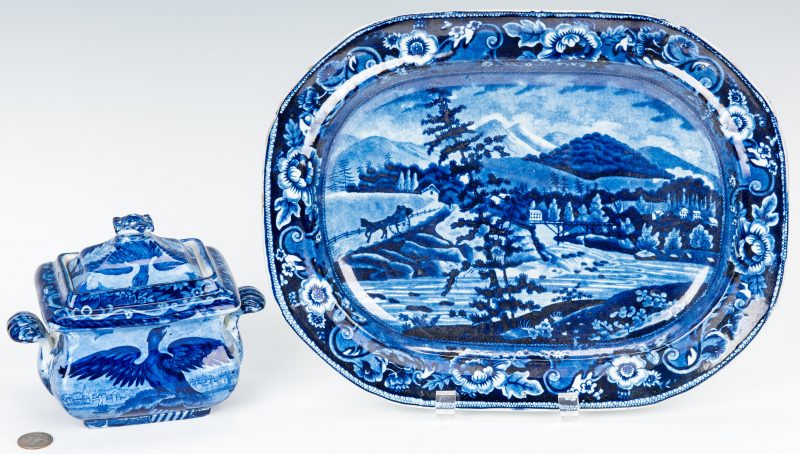 |
|
1st item: Historical Blue Staffordshire transfer printed covered sugar bowl, printed with scene of Boston Harbor, American Eagle, and shield. Manufactured by JOHN ROGERS & SON, LONGPORT, stamped on the base. 5 3/4″ H x 7″ W x 4 1/4″ D. Circa 1815-42. Note: Ex-collestion of Chester Creutzburg and David Martin, old collection label on the base. 2nd item: Historical Blue Staffordshire transfer printed octagonal platter, depicting the Junction of the Sacandaga and Hudson River, titled en verso upper edge. Impressed crown mark to the center for James & Ralph Clews, working 1818 – 1834. 11″ H x 14 1/4″ W. |
 |
|
Tiffany Studios table lamp comprised of a #470 Lemon Leaf shade with gold dore finish and a #587 Mock Turtle bronze base with three light sockets and a brown/dark green finish. Shade marked along the edge “Tiffany Studios/New York/470” and lamp base marked “Tiffany Studios/New York/587”. Base – 22 7/8″ H. Shade – 18″ dia. 23 1/4″ total height with base and shade. |
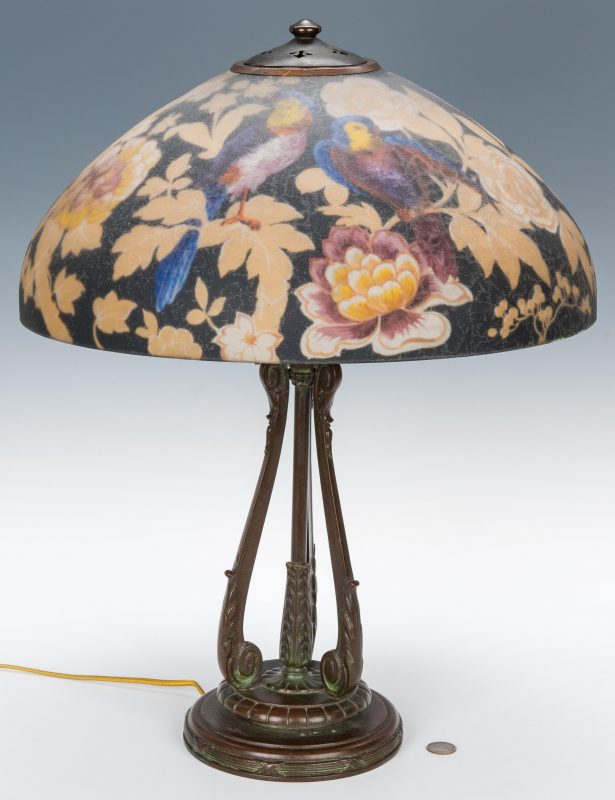 |
|
Handel art glass reverse painted table lamp, fitted with a “chipped ice” shade depicting parrots perched on a branch, flowers and a butterfly in colors of black, red, tan, cream, yellow, blue, pink and orange. The interlocking bronze ring signed “Handel Lamps, Pat’d No 979064”. Shade – 18″ diameter. 23 1/2″ total height of the lamp. More information in the coming weeks. |
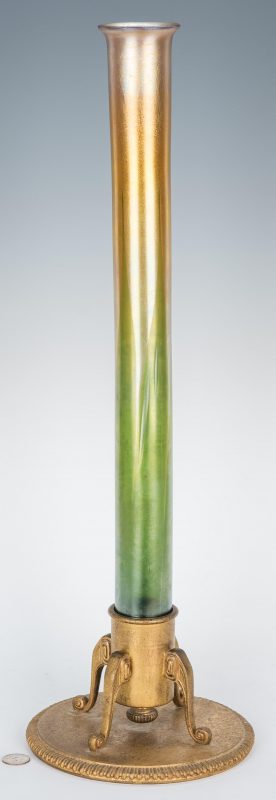 |
|
Tiffany Studios tall gold favrile cylindrical vase with green overlay, #715, set into a gilded bronze stand. Vase marked on the underside “L C Tiffany/Favrille”. Stand marked on the underside “Tiffany Studios New York/ No 715”. Vase measures: 22 3/4″ H. Overall w/ stand: 24 3/4″ H. 1st half 20th century. |
 |
|
Rene Lalique Opalescent Glass Ceylan Vase, circa 1924. Molded R. LALIQUE mark to underside with wheel cut script mark FRANCE. Ref. Marcilhac p. 418 No. 905. 9 1/2″ Height. Alternate spelling: Ceylon. Provenance: The estate of Mildred “Mickey” Brown of Nashville, TN, formerly of Detroit, MI. |
 |
|
Large Lalique Tanega vase, urn form clear glass vase with applied and raised green leaf design. Retains the original Lalique label to lower body, etched signature on the base edge, underside of base with the original “Made in France” label. 14 1/4″ H. 20th century. |
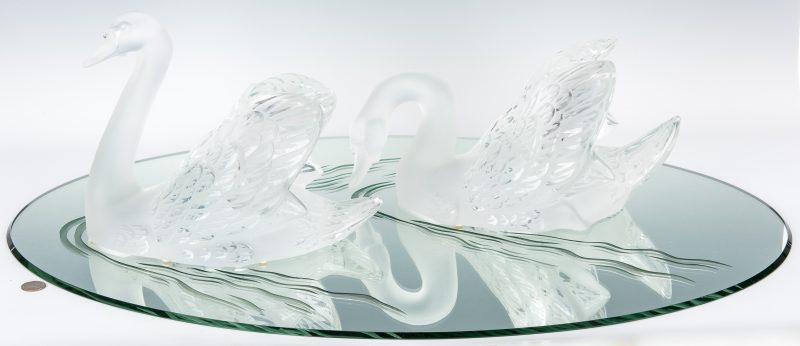 |
|
Pair of Lalique crystal Cygnes swans comprised of clear and frosted etched glass, inscribed “Lalique France” underside of each tail, together with the original glass mirror having an etched rippled water effect. Upright swan measures: 9 1/2″ H x 12 1/2″ L x 7″ W; downturned swan measures: 6 7/8″ H x 14 1/2″ L x 8 3/8″ W. Mirror measures: 33″ L x 24″ W. 20th century. |
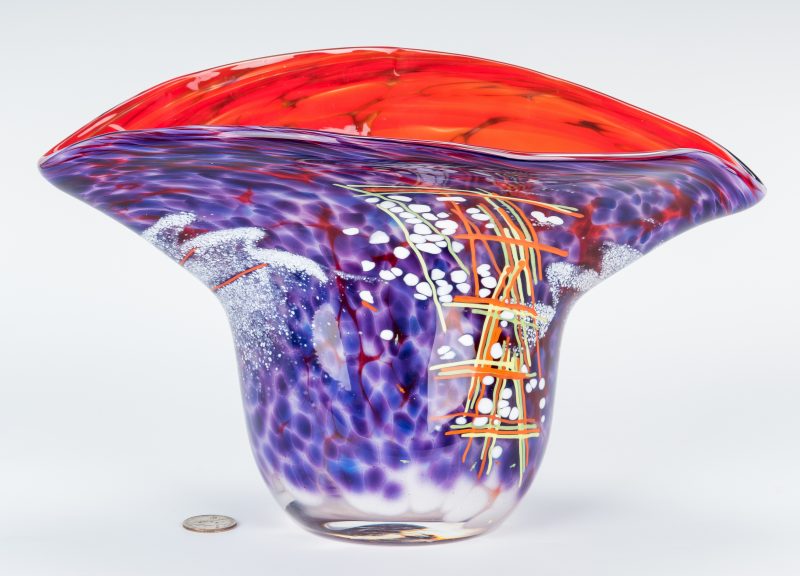 |
|
Signed Lino Tagliapietra (b. 1934) Italian Murano Art Glass vase, fan form in colors of red, purple,lime green, white and orange. Signed “Lino Tagliapietra” and dated 1990 on the base together with a stamp reading “Murano/Italy”. 8″ H x 12 1/2″ W x 6 1/2″ D. |
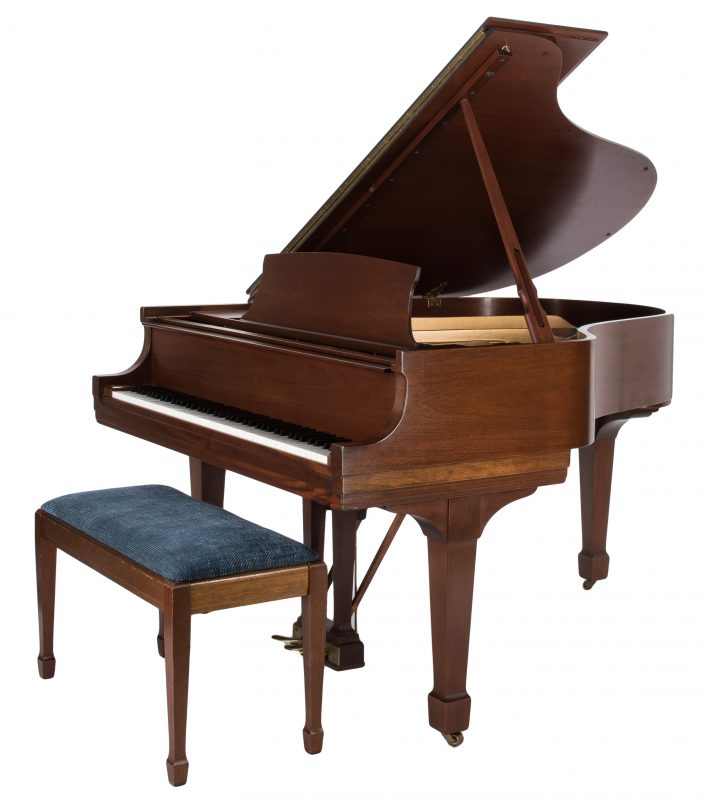 |
|
Steinway and Sons, New York, Model M Grand piano, mahogany case over tapered legs terminating into block feet and mounted with castors. Serial #451263 indicating a manufacture date of 1978. 37 3/4″ H x 56″ W x 74″ D. Fitted with a padded bench of similar design. |
 |
|
Royal Copenhagen Denmark Flora Danica Pattern porcelain round tureen and lid with gold trimmed reticulated borders encircling hand-painted flowers on white grounds. Includes Ranunculus Philonotis Ehrh. Swertia perennis L. tureen with Galeopsis Galeobdolon L. lid. Both with Royal Copenhagen marks, numbers, date marks, and Latin names, underside of bases, lid with two (2) paper labels. Tureen – 5 1/4″ H x 11 3/4″ W x 9 5/8″ D. Lid – 4″ H x 8 3/4″ W x 8 3/4″ D. Overall – 9 1/4″ H. Both with date marks for 1969-1973. |
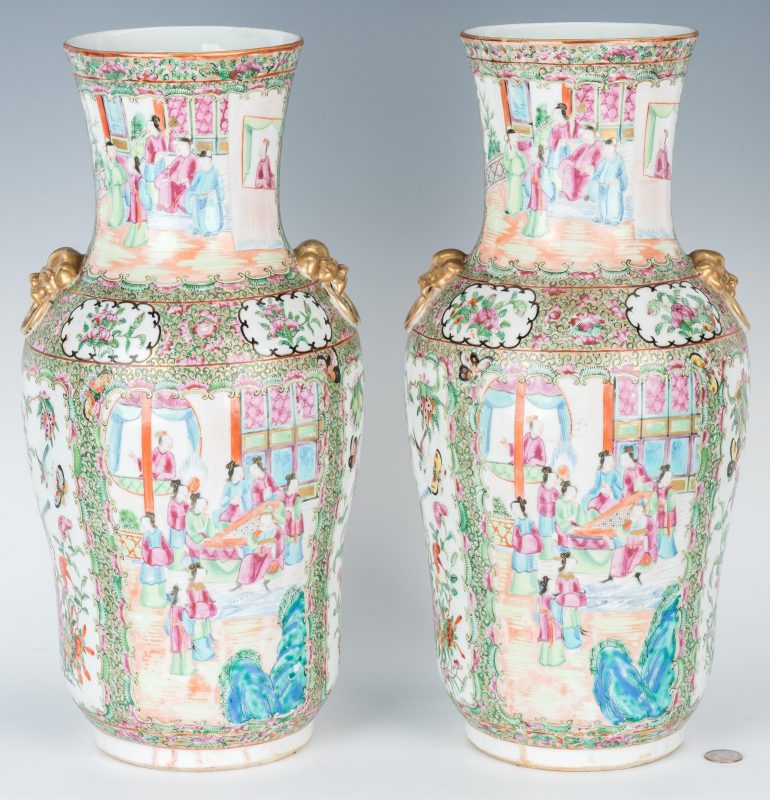 |
|
Pair of Chinese export porcelain Rose Medallion garniture vases, baluster form, polychrome paint decorated with reserves depicting flowers, birds and butterflies and scenes of various Chinese figures. Both with gilt rims and applied gilded foo dog handles to upper shoulders. 17 5/8″ H. Late 19th century. |
 |
|
Chinese Qing Dynasty porcelain plaque, possibly by Yu Huanwen (1852-1892) ,depicting a woman on a horse next to her servant and approaching another woman outside an estate wall. Chinese inscription upper left with one red seal. Mounted in late 20th century metal table with glass inset lower shelf. Plaque: 15 5/8″ L x 10 5/16″ W x 1/2″ D. Table: 23 3/8″ H x 10 3/4″ W x 15 7/8″ D. Chinese, late 19th century. Provenance: Private Knoxville, TN estate, descended in family. |
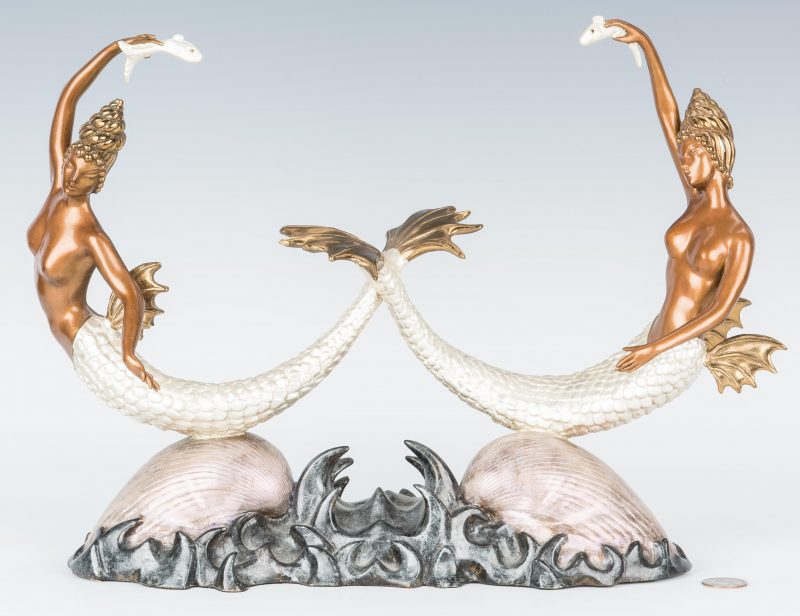 |
|
Erte (Romain De Tirtoff, Russian/French, 1892-1990) limited edition gilded and cold painted cast bronze sculpture titled “Sirens”. Inscribed “Erte”, back of center of base, numbered 47/375, foundry mark Chalk & Vermilion, and dated 1988, back of left side of base. 11 1/2″ H x 15 1/2″ W x 5 7/8″ D. |
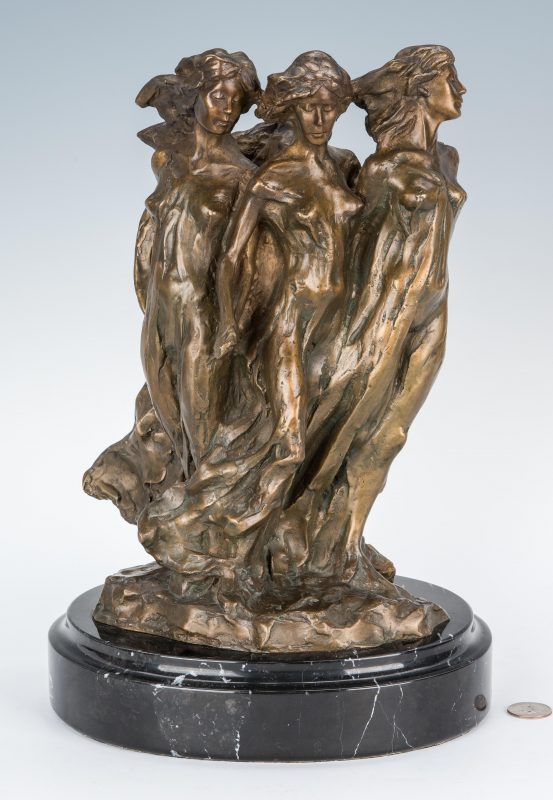 |
|
Frederick Elliott Hart (District of Columbia/Virginia, 1943-1999) bronze maquette sculpture mounted on a black marble base titled “Daughters of Odessa”. Limited Edition #143/195. Signed “Hart” in script above “(copyright) 2000 F. Hart 143/195″ with additional mark en verso of base. Sculpture – 12″ H. Overall – 14 1/8″ H x 10″ W x 8” W. American, 21st century. Provenance: Private Middle Tennessee Collection. Biography: Hart was born in Atlanta, Georgia and raised in South Carolina. A sculptor and stone cutter in the Classical style, Frederick Hart learned his art while an apprentice at the National Cathedral in Washington DC. Public recognition increased when he won a competition to design the facade of the Cathedral, which incorporated his thirteen year masterpiece of “The Creation”. He also designed “Three Soldiers”, realistic in style, for the Vietnam Veteran’s Memorial in DC to contrast with the abstraction of Maya Lin’s Vietnam Memorial. As a proponent of Realism, he was made an honorary member of The American Society of Classical Realism Guild of Artists. |
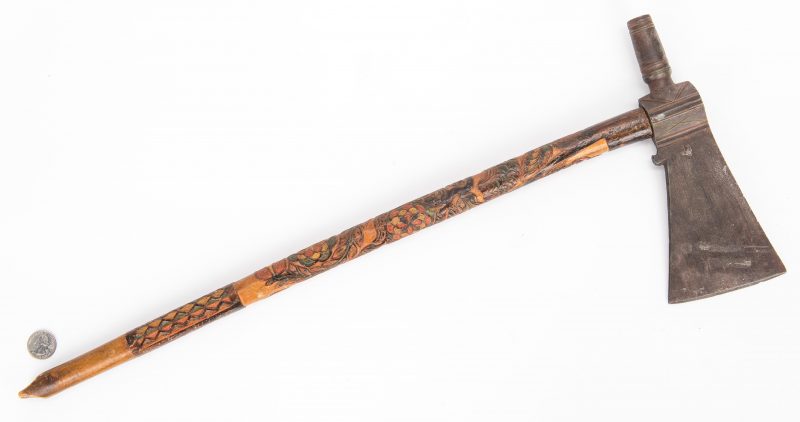 |
|
Native American Cree or Crow presentation tomahawk, iron blade with incised and colored decoration, handle with an all over carved relief floral and leaf design in colors of red, yellow, blue and green. Lower edge of handle inscribed “AEG Montgomery” for Sgt. Albert Ernest Garland Montgomery. 24″ L with blade x 9 1/2″ W, blade. Late 19th century. Provenance: Oral history states that this tomahawk was given to Sgt. Albert Ernest Garland Montgomery, Royal Canadian Mounted Police, 1890. Sgt. Montgomery participated in the 1885 Frog Lake Massacre, which was part of the Cree uprising during the North-West Rebellion in western Canada. Sgt. Montgomery later died from injuries when thrown from his horse while on parade in Prince Albert, Saskatchewan. |
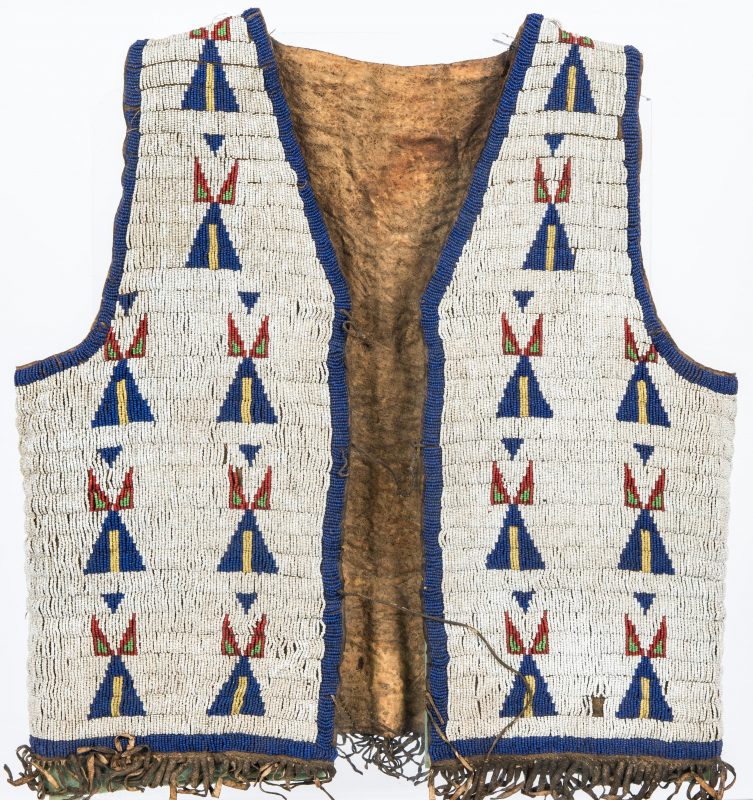 |
|
Native American Sioux beaded vest on hide. White beaded ground with red. blue, green and yellow beaded geometric designs to the front and back, retains some of the original fringe. Vest measures 21 1/2″ H x 20″ W. Framed: 27″ H x 25″ W. Late 19th century. |
 |
|
Stanocola Standard Oil Company enameled advertising sign having a bright yellow center with shield logo and bright red border, manufactured by The Baltimore Enamel & Novelty Company also known as Balto Enameling Company. Maker’s mark en verso. Sign measures 30″ dia. Provenance: This sign was originally displayed at general store in Tusculum, TN. Photos of the store outside of which the sign was displayed are included with this lot. |
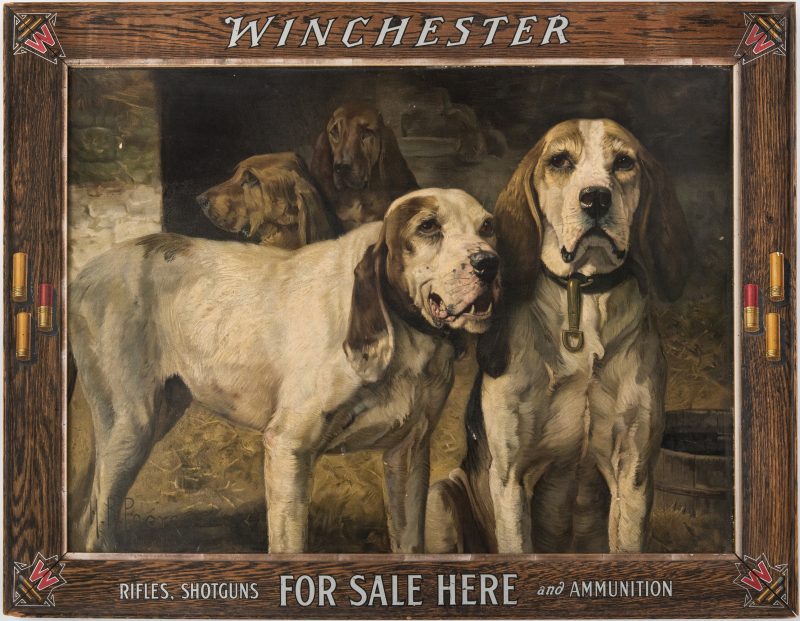 |
|
Henry Rankin Poore (Pennsylvania/Connecticut, 1859-1940) designed Winchester Rifle advertising sign, lithography on board, rectangular form, depicting four “bear-hunting dogs”. Signed “H. R. Poore /Philadelphia” in the stone, lower left. Housed in a Winchester Rifle wooden frame with stenciled advertisement across the top reading WINCHESTER and across the bottom reading RIFLES SHOTGUNS FOR SALE HIRE AND AMMUNITION along with painted or stenciled images of shotgun casings with the Winchester logo in each corner. Image – 25 1/2″ H x 34 3/4″ W. Framed – 32″ H x 41 1/2″ W. American, early 20th century. Provenance: Ex-collection Levi Strauss family. |
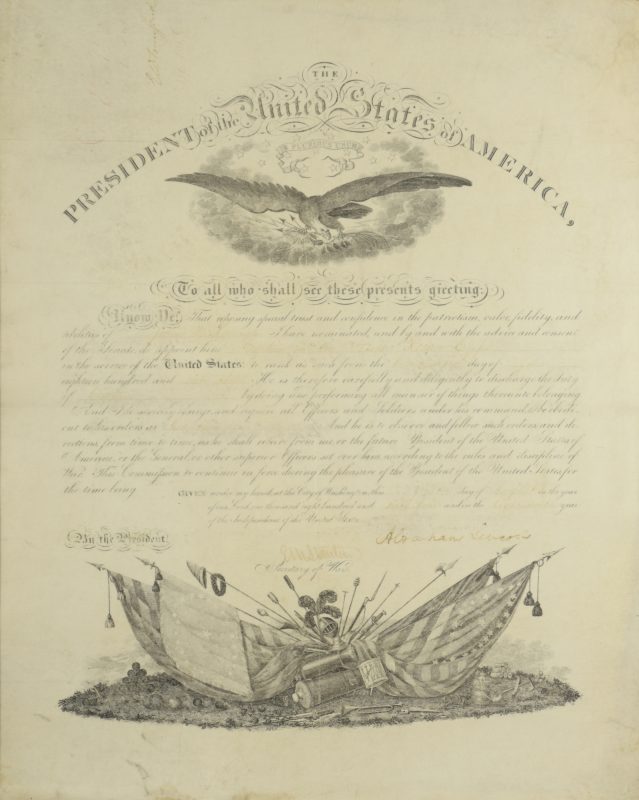 |
|
Civil War military appointment commission document signed by both President Abraham Lincoln and Secretary of War Edwin M. Stanton in black ink, dated July 1863, conferring the rank of Captain in the Veterans Reserve Corps to James H. Remington. Housed in black painted wooden frame. Sight – 19 1/2″ H x 15 1/2″ W. Framed – 22 1/2″ H x 18 1/2″ W. Note: James H. Remington was born in Warwick, RI in 1838. He attended East Greenwich Academy before going to Brown University, where he graduated as valedictorian in 1862. In September of that year he was mustered as captain of Company H, 7th Regiment, RI Infantry. His active military career only lasted until December 13, 1862 when he was wounded at the Battle of Fredericksburg in Virginia. A musket ball shattered his lower jaw and he was formally discharged by reason of disability in May 1863. Remington returned to Rhode Island where he was elected in April 1863 to the RI House of Representatives as a representative from Warwick. He resigned his seat in June as he was eager to return to military service. He accepted a captain’s commission in the newly formed Veterans Reserve Corps (initially called the Invalid Corps). He was immediately ordered to report for duty at Knight General Hospital in New Haven, CT where he assisted with the formation of companies for the Veterans Reserve Corps. After serving with several different units in Connecticut and Virginia, he settled in as captain with Company E, 1st Regiment of the Veterans Reserve Corps. The company’s primary duty was in Elmira, NY to guard rebel prisoners at Camp Chemung from November 1864 to June 1865. |
 |
|
Samuel Houston signed Tennessee land document, granting Robert Houston, assignee of Archibald G. Powell “fifteen acres by survey bearing date the 17th day of August 1825. Lying in the Ninth District in McNairy County on the waters of Cypre[s]s Creek…” dated July 26, 1828. 15 1/4″ H x 12 5/8″ W. Note: Sam Houston’s term as Tennessee governor lasted from 1827 until 1829, when he resigned and moved to Texas. Houston (1793-1863) later became the President of Texas and its Governor. He is the only person in American History to be elected governor of two states by popular vote. |
|
|
|
 |
|
18th century Moro (Philippines) Spanish style burgonet helmet, bronze with pierced crown and sides, hinged ear pieces, with receptacle in front for feather or other adornment. 6 1/8″ H x 12 ” L x 8 1/2″ W. |
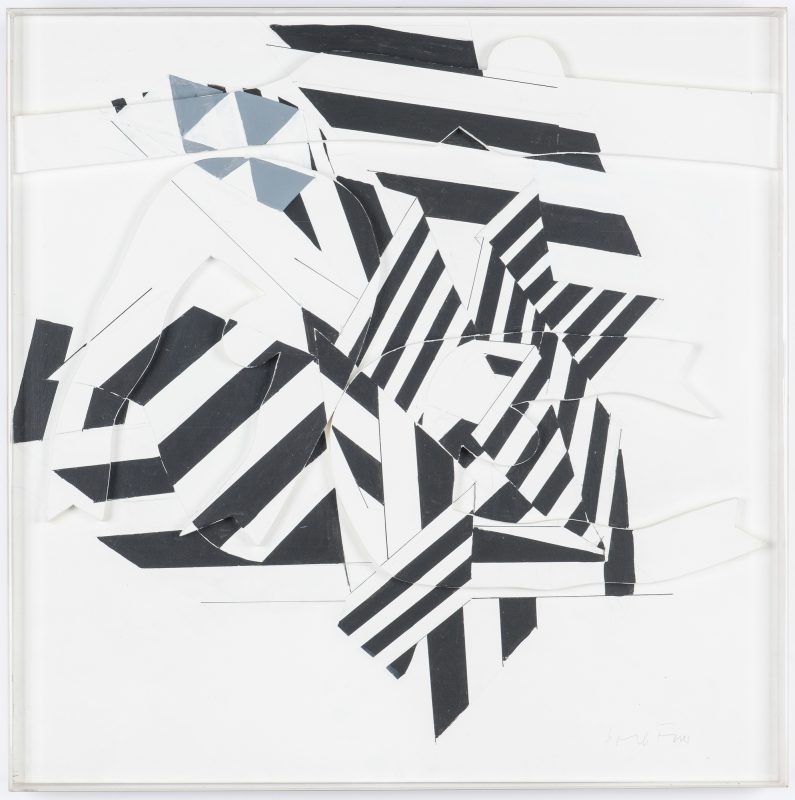 |
|
Perle Fine (New York/Massachusetts, 1905-1988) Abstract Expressionist three-dimensional mixed media black and white painted wood relief sculpture depicting two contorted human figures below a beam. Signed lower right. Artist’s name, en verso. Housed in a plexiglass shadow box. 24 1/4″ H x 24 1/2″ W x 2″ D. American, mid 20th century. Biography: A creator of abstract paintings and collages, Perle did work that inspired peace and serenity by using balanced lines and solid shapes on flat surfaces. She was a highly committed art teacher and spent twelve years as a professor of art at Hofstra University in New York. When she ended this career in her late sixties, she did minimalist collages in a series called “Accordment”. (source: Askart). |
 |
|
Hector Julio Bernabo Carybe (Argentina, 1911-1997) oil on canvasboard abstract painting titled “The Horseman” depicting the profile of a man, possibly a Conquistador or a Horseman of the Apocalypse, on horseback with a second man in an elaborate robe standing with his back towards the viewer in a desert landscape. Signed “Carybe” lower right. Signed and titled with measurements and biographical information en verso of board and frame. Housed in a wormy wood frame with a white painted rabbet edge. Sight – 17 5/8″ H x 23 5/8″ W. Framed – 24″ H x 29 7/8″ W. Mid/late 20th century. |










































































